




Vol.

Sarah Artemia Kronenfeld editor@thevarsity.ca
Editor-in-Chief
Caroline Bellamy creative@thevarsity.ca
Creative Director
Andrea Zhao managingexternal@thevarsity.ca
Managing Editor, External
Shernise Mohammed-Ali managinginternal@thevarsity.ca
Managing Editor, Internal
Mekhi Quarshie online@thevarsity.ca
Managing Online Editor
Ajeetha Vithiyananthan copy@thevarsity.ca
Senior Copy Editor
Kyla Cassandra Cortez deputysce@thevarsity.ca
Deputy Senior Copy Editor
Jessie Schwalb news@thevarsity.ca
News Editor
Selia Sanchez deputynews@thevarsity.ca
Deputy
Maeve Ellis assistantnews@thevarsity.ca
Assistant
Eleanor Yuneun Park comment@thevarsity.ca Comment
Georgia Kelly biz@thevarsity.ca
Business
Alice Boyle features@thevarsity.ca
Features Editor
Milena Pappalardo arts@thevarsity.ca
Arts
Salma Ragheb science@thevarsity.ca
Science Editor
Kunal Dadlani sports@thevarsity.ca
Sports Editor
Arthur Dennyson Hamdani design@thevarsity.ca
Design Editor
Kaisa Kasekamp design@thevarsity.ca
Design Editor
Zeynep Poyanli photos@thevarsity.ca
Photo Editor
Jessica Lam illustration@thevarsity.ca
Illustration
Olya Fedossenko video@thevarsity.ca
Video Editor
Aaron Hong aaronh@thevarsity.ca
andrewh@thevarsity.ca
Andrew
Back
Designers: Rebecca Hudescu
Cover Kaisa Kasekamp :
The Varsity would like to acknowledge that our office is built on the traditional territory of several First Nations, including the Huron-Wendat, the Petun First Nations, the Seneca, and most recently, the Mississaugas of the Credit. Journalists have historically harmed Indigenous communities by overlooking their stories, contributing to stereotypes, and telling their stories without their input. Therefore, we make this acknowledgement as a starting point for our responsibility to tell those stories more accurately, critically, and in accordance with the wishes of Indigenous Peoples.
From a faux ‘French starlet’ to the competition for the title of snow queen, The Varsity archives include some dramatic and romantic stories. With Valentine’s Day fast approaching, The Varsity decided to look back at some long-lost but highly memorable sagas related to love and sex at U of T.
64 inches of Gallic beauty
In 1956, The Varsity announced that the “Blue and White” student society would be selling raffle tickets for a chance to win an all-expensespaid date with Michelle Boudet, a French starlet.
Described as 20 years old, “64 inches of Gallic beauty,” and an ardent water skier, The Varsity told readers that Michelle had won recognition at the Cannes Film Festival the previous summer and was on her way to a career in Hollywood. Two enterprising student politicians had arranged her visit to U of T, as well as the accompanying raffle. The raffle was meant to supplement an ongoing multi-cause campus charity drive to fundraise for United Appeal.
The project had only one issue: Michelle Boudet did not exist.
A steady stream of promotional coverage in
The Varsity helped to generate interest, including a former Varsity editor’s account of a candlelit fling he’d had with Michelle after a chance encounter with her in France. Ticket sales exploded.
On October 13, 1956, Michelle debarked her plane at YYZ wearing a leopard print coat and went to a Varsity football game. A cabal of art students had plotted to kidnap her at the airport — collegiate kidnapping being a common pastime in those days — but aborted the scheme out of sympathy for the charity drive. At half time, Michelle walked out into the stadium and — before a crowd of 15,000 people — drew a name from a hat, then drove off in a Cadillac convertible.
The lucky winner — engineering student Terry Dawson — was promptly kidnapped by his friends but released in time to get picked up for his date. The two had dinner at the Granite Club and went dancing at an undisclosed location before Terry rushed home at 11:00 pm to meet with his steady girlfriend of two years.
After midnight, it came out that Michelle’s identity had been a hoax. The supposed French starlet was, in fact, an undergraduate student at the University of Montreal named Isabel Lafontaine. She had, in fact, met the former Varsity editor who wrote about her, but not in
Since the days of love letters underneath dorm room doors and orientation dating games, the ways that university students express love have changed on university campuses. The Instagram page Spotted U of T — one of the many anonymous confession pages where U of T students can share their thoughts and experiences — platforms student experiences with love at U of T.
The account, which has almost 5,700 followers as of February 11, has nearly 200 posts. In the past two weeks, every post featured at least one confession related to love or sex, ranging from people looking for a relationship to confessing love to strangers they noticed in their class. As first-year journalism student Emerson Nacawa put it in an interview with The Varsity, the confessions have become “horrendously down bad.” But why is that?
The Varsity spoke with multiple students and the anonymous handler of Spotted U of T about the value that these accounts hold for students, and what they can tell us about the state of love on campus.
Cameron Chassels, a first-year paramedicine
CORRECTIONS:
student, thinks anonymity is key to Spotted U of T’s appeal. “If people knew who was sending in these messages, there would potentially be a lot of beef or ruined images,” he wrote in a message to The Varsity. Students use the Spotted pages as a void into which they can shout dark confessions, ranging from crushes on professors and teaching assistants to dirty thoughts about a classmate.
“There [are] no consequences to anonymity,” added Nacawa.
Confessing may offer a psychological reward: in a 2017 study published in Frontiers in Psychology, authors Liat Levontin and Elad Yom-Tov suggest that individuals use online anonymous forums to disclose actions or impulses that they feel guilty about, similar to how one might use religious rituals such as confession. Analyzing posts on Yahoo! Answers, the authors find that, when people ask questions that imply guilt, respondents tend to offer answers that relieve the asker’s guilt — providing positive feedback.
In a recent piece for Spectrum Magazine, Samuel Girven wrote that many confession pages become settings for individuals to simply state what’s on their mind. As one interviewee suggests in the Spectrum piece, maybe it boils down to fear of missing out — we simply want to know.
A sports article published in issue 17 entitled “Victoria Mata, UTSC’s multi-sport athlete turned soccer coach” incorrectly
France — at the Canadian University Press conference held in Ottawa two years previous.
The Varsity refused to name the orchestrators of the scheme, but admitted that they had been in on it the whole time, writing, “[We] had a major part in the fraud… and we’re not sorry.”
The story was reported on far and wide. The Varsity of the time claimed it even reached TIME Magazine, although we at today’s Varsity could not confirm this. The duped engineer told The Varsity he was not upset by the lie, and added that, starlet or not, he would never forget her. In general, it seems that the 1,174 students who paid 25 cents for a chance to go out with Michelle — raising a total of $300, surpassing the fundraising efforts of University College, Trinity College, and St. Michael’s College — took the reveal in good spirits. In the aftermath, students interviewed by The Varsity lauded the affair for bringing energy and vibrancy to an otherwise dead and dusted campus.
Snow Queen
Also in the 1950s, an annual Winter Festival culminated in the crowning of a campus “Snow Queen.”
University administrators had deemed a beauty contest an inappropriate fair for a centre of thought and learning, so the carnival organizers agreed to instead judge contestants by more substantial attributes including “freshness,” “logsawing,” and “enthusiasm.” The queen-aspirant would also compete at snowshoeing and pancake-flipping out at the Caledon Hills farms.
The Varsity announced that the winner would be crowned by the warden of Hart House, to a serenation by the Glee Club.
Counteracting loneliness on campus
According to the anonymous handler of the Spotted U of T account, most confessions posted to the page are romantic.
Sarah Thielmann, a first-year UTSC student studying psychology and health sciences, wrote to The Varsity that she believes the posts reflect a “surge of loneliness.”
Multiple studies have found that relationship status changes and interest in dating peak during the winter months, which may derive from a desire to compensate for lower levels of serotonin caused by lack of sunlight or from wanting to cuddle against the cold.
The Spotted U of T handler wrote that they believe loneliness is a big concern for U of T students because of the “rigorous academics and the lack of a unified campus culture.” This concern about fostering community has come up before on similar pages: In a 2021 article published in University of Calgary (U of C) newspaper The Gauntlet, the administrators of the U of C Instagram page @ uoftconfessions discussed how they started the account as a way to foster community.
According to the Student Experience in the Research University survey conducted by the Centre for the Study of Higher Education, U of T undergraduate students are much more likely to disagree with statements such as “I feel that I belong at University” and “I feel valued as an individual at this campus” than students at other research-intensive universities.
Chassels believes that loneliness can explain why so many people use or follow the Spotted U of T pages. “[The account’s sense of community] counteracts the loneliness that people feel on campus,” he wrote. The page provides a space for people to vent and read potentially relatable confessions, creating an “overarching sense of community.”
During its Annual General Meeting (AGM) on November 29, 2023, the University of Toronto Mississauga Students’ Union (UTMSU) passed a motion “in support of Palestinian liberation and the end of the occupation in Gaza.” The motion included an amendment that the union adopt “[a] ‘pro-Palestine stance’ that extends to all clubs and services funded by the UTMSU.”
So what does this mean for clubs? The motion’s language has since stirred some controversy amongst students, who raised concerns about whether the UTMSU will withhold funding from clubs that take a more pro-Israel stance or who opt not to take a stance. The union has yet to clarify how it will implement the motion.
“A little bit vague”
At the AGM, students voted on a motion requiring the union to call for an immediate ceasefire in Gaza and “stand in support for the Palestinian people.” During the discussion period, one student proposed an amendment that the union take a general “pro-Palestine stance” that would extend to “all clubs and services funded by the UTMSU.”
The motion did not specify whether it aimed to influence clubs’ stances or funding. When asked, the student clarified that the amendment should apply to clubs that had “anything relevant to do with this clause,” noting that it would not apply to non-political clubs.
During the meeting, another student raised objections about how the amendment would impact clubs with connections to specific departments, such as course unions. “By putting this in, you’re essentially blanketing us all and removing our right to actually have a proper discussion,” they said.
UTMSU Executive Director Felipe Jiyudim Nagata clarified during the meeting that the UTMSU can’t mandate clubs to take certain stances but can withhold funding or recognition from them. He raised the example of the UTMSU stopping funding anti-abortion clubs after the union adopted an official prochoice stance.
Nagata asked the student who initially proposed the pro-Palestine amendment to clarify their intentions about how this would affect clubs funded by the UTMSU. The student stated that they intentionally kept the motion “a little bit vague.”
Hillel U of T condemns the motion
In a statement posted on its Instagram on January 10, Hillel U of T — the U of T branch of the North American Jewish campus organization — voiced concerns about the union’s decision to adopt this position, pointing out it could potentially compel funded student clubs to adopt a pro-Palestine stance or risk losing funding.
The organization asserted that the passage of such a motion by a student governance body amid “a time of unprecedented antisemitism” was “unacceptable and dangerous.” Hillel U of T additionally wrote that it condemns “[the] UTMSU’s obsession with demonizing Jewish students and their allies on campus.” Hillel UofT has criticized the UTMSU in the past for its statement in the wake of October 7, alleging that it showed a “lack of care” for Jewish students.
In response to the motion, Hillel U of T announced that it planned to speak with the university administration, urging them to take decisive action to prevent the UTMSU from “abusing their podium.”
The U of T student body includes 28,433 international undergraduate and graduate students, coming from 170 different countries and regions, across its three campuses. Among this, around 29 per cent of students, many packed their bags, left behind their loved ones, and moved miles away from home to continue their education.
Aside from family and friends, some students also leave their significant others and transition to long-distance relationships. Even among domestic students, some navigate relationships with people who live in different cities or provinces.
The Varsity spoke to two U of T students who shared their experiences in long-distance relationships (LDRs) and how they navigate them: the challenges, considerations, and even some unexpected benefits.
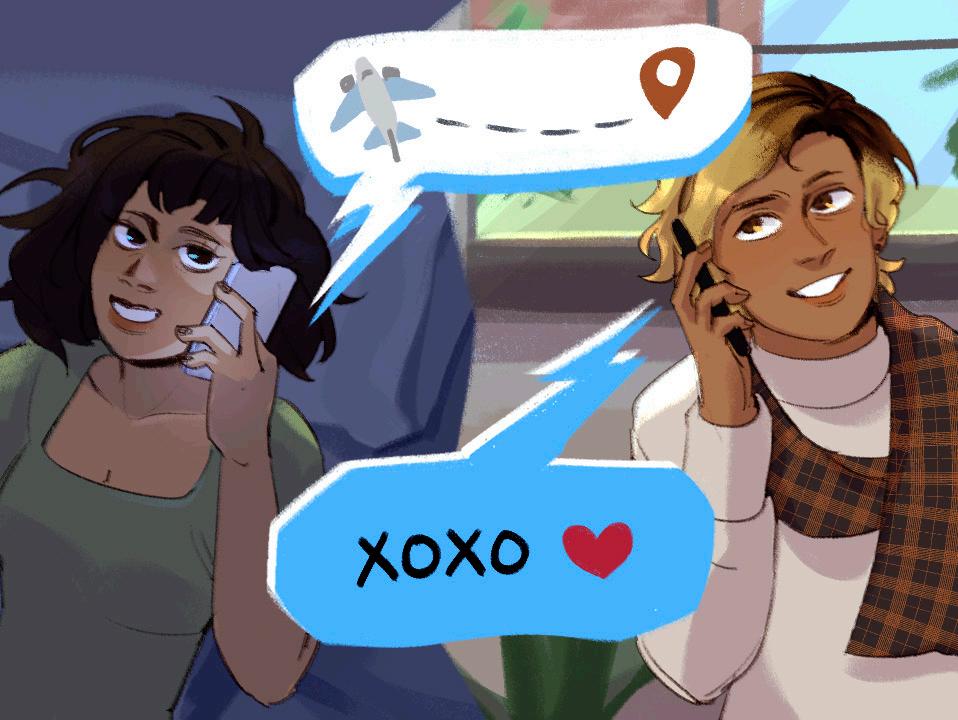
One UTM student from two clubs spoke to The Varsity about the UTMSU’s motion, although they requested to stay anonymous because of fears for their safety on campus.
They told The Varsity that they believed, “morally speaking, [the amendment] is undemocratic.” The student pointed out that any attempt to force clubs to adopt a specific political stance, claim goes against the spirit of Section 2 of the Canadian Charter of Rights and Freedoms, which guarantees freedom from compelled association — that is, from being forced to become part of an organization.
The student also cited the UTMSU’s own mission statement, which upholds the rights of individuals regardless of their personal or political beliefs and condemns acts of discrimination based on ethnic or national origin. They argued
that the motion contradicted these principles by potentially infringing on the autonomy of student clubs.
The student raised questions about the enforcement of the motion and its consequences for clubs that choose not to take a stance. They also brought up worries about the potential repercussions for clubs that opt not to take a stance on the current violence in Gaza, highlighting the lack of clarity about potential consequences for student organizations in the motion. “[Is the UTMSU] mandating all clubs to take a stance that condemns Israel?” they questioned.
The UTMSU has not responded to The Varsity’s repeated requests to clarify the motion’s ambiguity and how the union will implement the motion.
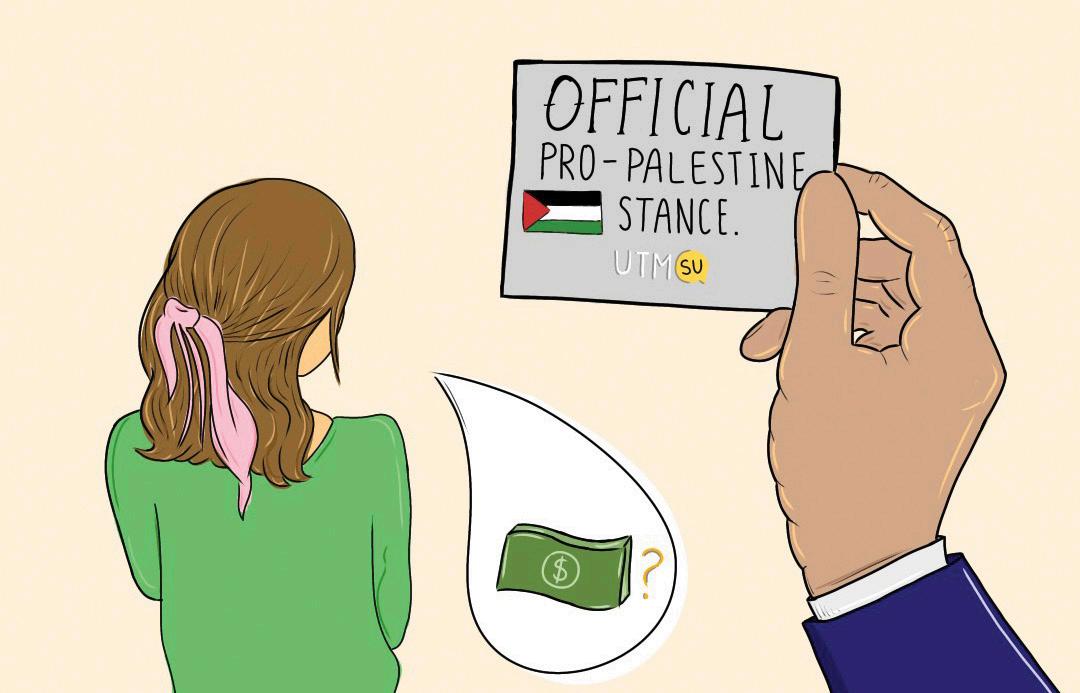
The challenges
Vincent Quach — a fourth-year student pursuing an English major, and minors in mathematics, and education and society — met his girlfriend at a convention in 2022, and they have been together long distance since then. While Quach and his partner both live in Canada, they find it challenging to meet since they live three hours away from each other.
Quach mentioned that the distance restricts how physically intimate he can be with his partner — he can see her “maybe a week or two in a full year.”
“You start thinking, ‘Man, I can really go for a hug right now.’ And then she’s hundreds of kilometres away,” he told The Varsity
Ahan Kalra Mathur — a second-year Rotman student — dated his partner for a year and a half before university. They met in Dubai through common friends in 2020 over the pandemic. In 2022, Mathur came to Ontario to study at Rotman, and his partner moved to Vancouver for school.
For Mathur and his partner, time differences are a significant hurdle. He told The Varsity that it was hard for him and his girlfriend — who has since moved back home — to connect over the summer due to the eight-hour time difference between Canada and the United Arab Emirates.
Quach also said that the inability to see his girlfriend is upsetting because, during rough patches, he doesn’t have the option to approach her and check-in. “Assuming something goes wrong, you can’t go show up to their doorstep and, like, knock on their door and see if they’re okay,” he said.
The positives
According to Mathur and Quach, LDRs have their benefits as well.
Mathur pointed out that being in an LDR has helped him foster a sense of individuality. To him and his girlfriend, a relationship is “something that’s a part of us, but it’s not our whole personality.” Being away allowed him to discover more about himself — and, in turn, about his relationship. The distance has allowed them to “understand what the other person wants and needs and how previous wants and needs have changed.”
Quach said that the experience has made him a better communicator. Before he met his partner, he was somewhat closed off and didn’t always share
things with others. However, since they started dating, he has opened up and started sharing glimpses of his day more often. He has also become more patient, recognizing that although they live separate, busy lives, they can still take the time to talk at the end of the day.
Maintaining an LDR
Although the evidence on the longevity of LDRs appears mixed, some research shows that they tend to exhibit more stability — although this may be due to greater commitment when partners enter the relationship.
When asked about important factors that helped him maintain an LDR, Quach explained that he and his girlfriend had initially met at a convention, after which they connected over Discord. In other words, the foundation of their relationship was a long distance from the start. This dynamic differs from that of someone — like Mathur — who dated their significant other in person before beginning a long-distance relationship.
Regardless, Mathur and Quach both emphasized the importance of trust in building a relationship. “If you don’t trust the person, you don’t really have a proper relationship,” said Mathur. He stressed that people have to earn trust, so both individuals should show the other why they should trust them.
Quach mentioned that respect for each others’ time was vital for an LDR. He added that mutual understanding of the other person’s choices and way of life was also important.
As U of T students, they juggle university life and their relationships. Quach finds it helpful to set a routine and set aside time to talk to his girlfriend at the end of his day. To Mathur, talking to his partner is a delight after a long and hectic day of studies and extracurricular activities.
“You should have fun talking to your partner. And communicating with your partner shouldn’t feel like a chore,” Mathur said.
Both mentioned the importance of showing that you care and think about your partner. Aside from talking often, Mathur sets up virtual dates with his girlfriend. Quach explained that he tries to write letters to his partner, and regularly texts and calls with her.
SCSU hosts tour at Scarborough Museum on intersections of LGBTQ+ and Tamil identities
Canadians have made to Ontario.
Scarborough Campus Student Union (SCSU) President Amrith David decided to organize the tour. “I wanted to bring students in this space, not just for them, but for myself as well to learn about what the different identit[ies are] of being Queer, and how that plays into the whole Tamil heritage,” David, who is Tamil, told The Varsity SCSU collaborated with the Scarborough Museum and the U of T Tamil Student Association (TSU) to bring the students on the tour, where they viewed art from a variety of artists across the world.
History in the making
Students read Tamil words on banner at Scarborough Museum.
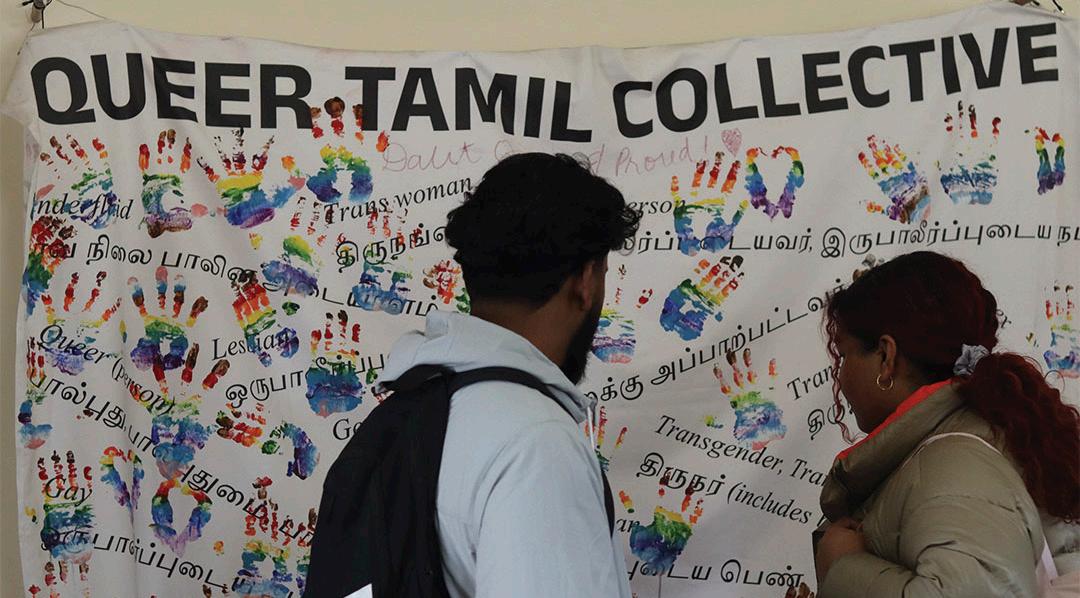 Muzna Erum Associate News Editor
Muzna Erum Associate News Editor
On January 31, 17 U of T students visited the Scarborough Museum in Thomson Memorial Park to tour an exhibit put on by the Queer Tamil Collective (QTC) — a nonprofit, Torontobased organization that supports, empowers, and advocates for LGBTQ+ Tamil artists, focusing on the violence that individuals face carrying these intersectional identities.
The event coincided with Tamil Heritage Month. Tamil refers to both a language and
an ethnic group. Many Tamil people practice Hinduism, while some practice Jainism, Christianity, and Islam.
The language is spoken primarily by people from southern India and Sri Lanka. The Indian government declared Tamil a “classical language,” meaning that the language appears in ancient literature and transcripts as far back as 1,500–2,000 years ago.
In 2014, Ontario’s Legislative Assembly passed Bill 165, designating January as Tamil Heritage Month to celebrate the political, economic, and cultural contributions Tamil
On January 31, the Women and Gender Studies Institute (WGSI) held a panel discussion where WGSI faculty members and alumni shared their experiences in the institute. With 215 people packed into the William Doo Auditorium, the 10 panellists discussed the institute’s beginnings, impacts, and direction for the future.
A brief history of the WGSI — challenges and successes
In 1971, a teaching group established one of the first women and gender studies courses at U of T, called “Women in the Twentieth Century.” Ceta Ramkhalawansingh — an undergraduate student at the time — was one of the group’s members, and spoke about her experiences on the panel.
She told the crowd about the WGSI’s history from her own perspective, and the challenges and successes the group faced when setting up that early Women and Gender Studies (WGS) course.
After the Interdisciplinary Studies Department agreed to host the course, the group faced difficulties finding a faculty sponsor. “Not a single faculty member on the St. George campus was willing to touch [women’s] studies,” Ramkhalawansingh recalled during the panel. Eventually, the group found an American faculty member from the Scarborough campus to be the “titular head of the program.”
Curriculum posed another challenge — Ramkhalawansingh told the audience that they couldn’t find a consolidated body of information for the course to cover. “We had to develop everything,” she shared. “Each of us took turns from our own discipline… we became each other’s teachers.” Despite the challenge, she told the crowd that their ability to teach one another exemplified success for
At February BOD meeting, VP equity discusses balancing bursary backlog
Regenesis levy
During its February 8 meeting, the Scarborough Campus Students’ Union (SCSU) Board of Directors (BOD) agreed to run a referendum where students will determine whether each full-time student will pay $7.23 each session to fund Regenesis UTSC — one of the branches of Regenesis, an environmentalism club that exist across the three campuses. SCSU executives noted a lack of sophistication in the club’s budget but will leave students to decide whether to vote in favour of the levy.
SCSU Vice President (VP) Equity Vyshnavi Kanagarajamuthaly also gave insight into a backlog of Academic Bursary applications, which she attributed to the month-long VP equity vacancy.
In a presentation to the board, Regenesis UTSC VP Operations Aleema Abbas highlighted the importance of obtaining a levy for the club’s programming. If passed during the spring elections’ voting period running March 4–6, full-time students would pay a fee of $7.23 per session and part-time students would pay $3.62 per session starting fall 2024.
According to Regenesis UTSC’s submission to the BOD, the collected fees would go toward environmental initiatives and programming on and near campus, including a free store that provides students clothes and books while diverting waste; free meals and cooking workshops for students; and a program to reduce food waste on campus by rescuing and distributing food from catered events.
During a referendum in the University of Toronto Mississauga Students’ Union’s spring
The exhibition, titled “ஊர்,” or “Oor,” included 11 artworks — ranging from ceramic statues to paintings to films — from LGBTQ+ Tamil artists from eight different countries or regions: Canada, the UK, Germany, Sri Lanka, Malaysia, Singapore, Guadeloupe, and Trinidad.
According to the exhibition catalogue, “Oor is a multifaceted Tamil word that could mean location, village, home, and identity.” With the exhibit — which ran from June 2023 and closed at the end of January — the QTC aimed to explore topics including identity, belonging, sexuality, displacement, genocide, colonialism, caste, and class.
In Sri Lanka — where more than five million people speak Tamil and Tamil people make up the largest minority group — homosexuality remains illegal and punishable by prison. In May
the teaching group.
Along with the course, the teaching group held a series of free public lectures that year, attended by over 250 people. “We had experts from all over the community who came and gave lectures on health, politics, literature, and so on. And it was that success from the first year that led [other] departments to offer additional courses,” Ramkhalawansingh said.
The panellists shared various memories from being a part of the WGSI as faculty members and students.
Mary Nyquist — the 1983–1991 director of the WGS program, which, at the time, only existed at the UTSG campus — recalled a specific moment from setting up the WGS program. “One of my colleagues in the English department introduced me as someone working in ‘clit lit.’ And I sort of thought, after that, I can deal with any resistance,” she told the laughing crowd.
Nyquist also shared that she had male colleagues who couldn’t directly look at her because of her involvement in WGS: “They were just so embarrassed at the existence of someone who was in women and gender studies.”
Angie Fazekas — an assistant professor in the teaching stream at WGSI — said that when they chose a PhD program, U of T’s WGSI stood out to them because it allowed them to “combine cultural
2023 elections, UTM Regenesis successfully campaigned for a five-dollar per-session fee charged to full-time students and a $2.50 persession fee charged to part-time students, which students will pay starting in fall 2024.
According to the submission, Regenesis UTSC “differs from the typical student club, as we provide eco-student services, which require regularity and reliability, for which student staffing and suitable space and equipment are needed.”
At the SCSU board meeting, the board did not vote to implement the levy itself — they voted to allow students to determine during the upcoming spring general elections whether they want to accept the levy.
“It’s up to the student body,” SCSU President Amrith David told The Varsity in an interview. “We are an impartial unit in this referendum and [the] elections process in general, so we do not get involved with anything.”
Abbas presented the board with the proposed budget justifying Regenesis’ levy, but SCSU VP Operations Akaash Palaparthy noticed inconsistencies in their plan. “Their budget was very rudimentary,” he told The Varsity in an interview. “A budget needs to show how it proceeds in the next five years, but their numbers remain the same.”
Palaparthy highlighted the importance of oversight when creating budgets that impact funds contributed by the student body, since, for a
2023, however, Sri Lanka’s Supreme Court found a bill seeking to decriminalize homosexuality not inconsistent with its constitution — in other words, constitutional — clearing the way for parliamentary debate and vote. In the exhibition catalogue provided by QTC, the collective shares that some members of the QTC have been “disowned, shunned, and ostracized” by Tamil communities because of their LGBTQ+ identities.
“Opened my mind”
One of the pieces that caught students’ attention was a giant banner created at the inaugural Queer Tamil Pride event hosted in June 2022 at the Scarborough Museum. The banner included a glossary of LGBTQ+ affirming words in Tamil translated to English, overlaid with coloured handprints. According to the QTC digital catalogue on the exhibit, the banner symbolized welcoming and validating those with LGBTQ+ identities.
“No one really talks about the Queer aspect,” Lackzhanth Anantharajah, a second-year majoring in city studies and a member of the TSU, told The Varsity. “Coming here, it really opened my mind to see how prevalent it is, in our society.”
David liked how pieces in the exhibit demonstrated a form of resistance against censorship. “These [artists] are doing the work to resist colonial powers and resist ‘the ways that things have to be done,’ which I really appreciate,” explained David.
studies, queer storytelling, and transnational and postcolonial theory.”
In an email with The Varsity, Fazekas wrote, “[WGSI seems] to attract a cohort of students in this program who are not only brilliant and creative but also deeply invested in global change and activism. It’s very inspiring to learn and work with them.”
Takeaways from the WGSI event
Fazekas wrote that their “biggest takeaway” from the panel discussion was “the incredible amount of work and passion” that faculty members have put into crafting and sustaining the program. “So many people, working so hard, came together to create and grow WGSI,” they wrote. “The event felt like a celebration and an expression of gratitude for their work.”
Claire Li, a third-year student studying psychology and women and gender studies, attended the event because it was offered as an extra-credit opportunity in one of their courses, WGS360 — Making Knowledge in a World that Matters. In an email to The Varsity, they shared a reflection they submitted for their class discussion.
“It was incredibly touching and beautiful to hear former students share the impact that the WGS program has had on them,” Li wrote. “The speakers emphasized that progress is a continuous process by students, faculty, and community members alike.”
student, every dollar matters.
“Regenesis [UTSC] will have to come up with their budget allocation and show the student body where the money is going towards. And that's up to them,” said David.
Bursary backlog
During the meeting, Kanagarajamuthaly raised a concern about the SCSU Academic Bursary, which aims to help eliminate the financial barriers students face. Eligible students can receive up to $500 in academic relief per semester.
Kanagarajamuthaly noted a backlog during her transition period. “It is unfortunate that some of those students who did have emergency crises at that time weren't able to receive their funding right away,” she said.
Kanagarajamuthaly has informed students who applied via email that the union faced some “internal constraints” that prevented it from putting through applications. She has received positive feedback from students, but the SCSU is still working through applications.
“We are optimistic that all pending Academic Bursary and Emergency Grant applications will be reviewed by the end of this month,” wrote David in an email to The Varsity
Regenesis UTSC did not reply to The Varsity’s request for comment in time for publication.
With the cost of dining out rising as quickly as our tuition, planning a romantic date on a limited budget may seem difficult as Valentine’s Day approaches. But don’t fret! From stargazing to taking a stroll through a park, we have compiled a list of inexpensive date ideas that will not break the bank while also giving a romantic touch to your day.
Whether you are a student on a tight budget or simply prefer a more intimate and creative approach to celebrating love, these affordable options provide the ideal balance of charm and cost-effectiveness, allowing you and your significant other to enjoy romantic moments without going over your budget.
Indoor options: Museums, a tour, and one out-of-the-box date idea
You can indulge in a more sophisticated date, exploring art and history, by visiting one of Toronto’s museums or galleries for free. For instance, you can take your significant other to the Art Gallery of Ontario — permanent collections and special exhibitions are free for those aged between 14–25 years old with the free annual pass. Even without a pass, the permanent collection is free for everyone to browse from 6:00–9:00 pm on Wednesdays.
The Royal Ontario Museum is another option that provides free admission for students on Tuesdays. Alternatively, the GTA has numerous smaller galleries open to the public daily, such as the Art Gallery of Mississauga and the Taglialatella Gallery in Yorkville, which exhibit modern and bold contemporary art.
Discover the mysteries of the cosmos with the free Astronomy Public Tours led by U of T graduate students in Room 102 at the McLennan Physical Laboratories. These events take place on the first Thursday of most months
and include a 45-minute presentation on an astronomy topic, a telescope viewing in the observatory, and interactive tools like Virtual Reality headsets and 3D-printed models. With no registration required, this is a perfect stop for a spontaneous activity in the evening that starts at 8:00 pm.
If you have seen the movie 500 Days of Summer, you know that an ordinary shopping
and aesthetics by discovering common ground or charming differences that add, perhaps, a colourful touch to the tapestry of your relationship.
Outdoor and scenic options: Skates, treats, pictures, and a zoo
You can skate hand-in-hand under a blanket of stars along the figure-eight-shaped loop at

trip to IKEA can be transformed into an entertaining and unique date. There are IKEA locations in Etobicoke, North York, in downtown Toronto’s College Park, and at Scarborough Town Centre. With your partner, you can weave through the aisles of home goods, peruse showrooms, and find reasonably priced home furnishings while role-playing adults who make financially responsible decisions. Or, you can share a plate of eight-piece Swedish Meatballs for $8.99 — or plant-based meatballs for $7.99 — at their bistro. Discuss your shared tastes
The Bentway’s skate trail, all without spending a dime if you have your own skates. As the car lights shine overhead on the Gardiner Expressway, The Bentway transforms into a winter wonderland, offering couples a picturesque setting as they glide gently across the ice. This shared adventure provides a unique background for your free-spirited skate from 5:00–9:00 pm on weekdays and 12:00–9:00 pm on weekends.
Alternatively, you can begin your date outdoors with a leisurely stroll through Trinity
Bellwoods Park, where the canopy of trees and open spaces create the ideal setting for a romantic rendezvous. Spread out a blanket, have a picnic, or simply enjoy each other’s company as you take in the natural beauty of this urban oasis. Walk through the park and you venture into Ossington, where you will find a treasure trove of quaint cafés such as 135 Ossington, Forget Me Not Coffee, and Found Coffee Roasters.
If you want to preserve a memory of your day, head to the Drake Hotel on Queen Street West, where they have a photo booth to help capture your happy and intimate moments. For only five dollars — as of last August, at least — you can get two strips of photos and a tangible memento of your cozy and romantic day out.
You can also visit the Scarborough Bluffs, a breathtaking natural hideaway with various activities easily accessible by public transportation. This series of towering cliffs offers breathtaking and panoramic views of Lake Ontario. The trail is approximately 6.4 kilometres long and has an elevation gain of 131 feet, with a hiking path meandering through greenery and wooded areas surrounding the bluffs. Bluffers Park is a must-see spot along the trail, where you can walk from the top of the main viewpoint back down to the parking lot and then to the beach on the right side.
For one last dreamy date idea, pack some food and a cozy blanket and head to High Park for an easy — and affordable — way to spend a sunny day. A scenic stroll through the park lets you to enjoy the expansive green spaces and positive vibes of one of Toronto’s most iconic hangout spots. The High Park Zoo is a free and enjoyable way to break up the day. It features bison, deer, llamas, peacocks, and other animals. Finish your leisurely day with hot chocolates at the Grenadier Cafe, as its comfortable setting and breathtaking views make it an ideal place to relax and unwind before returning home.

February 12, 2024
thevarsity.ca/section/arts-and-culture arts@thevarsity.ca
So, you don’t have plans for Valentine’s Day. You're single, and February 14 will only amplify your awareness that you still live vicariously through Hallmark movies. You’re not alone! Countless singles dread Valentine’s Day, with nothing better to do than concoct hate comments for cutesy Instagram couples.
Rather than having to waste your witty insults on couples this year, however, info-dump your way into feeling better about your relationship status; let them know how contradictory the history of Valentine’s Day is from its modern portrayal! After learning about the not-so-romantic, unideal stories surrounding the origin of this sappy holiday, you yourself may think twice before envying couples this February.
Roses are red, and so is blood
Ever wonder where the ‘Valentine’ in Valentine’s Day comes from? Traditionally, Valentine’s Day celebrates love and the other emotional, lovey-dovey couple stuff that makes many people want to projectile vomit. It’s almost unbelievable that Valentine’s Day can get any grosser than that, but it sure does if you find blood more nauseating than PDA.
As one Christian legend goes, Valentine’s Day originated from three Catholic-recognized martyrs who all happened to be named Valentine or Valentinus. Yes, three different St. Valentines were all coincidentally martyred on February 14. This detail has sparked a theological argument that St. Valentine was only one person. Despite this speculation, if it’s true, a coincidence like that might deserve to be given its own day.
According to History.com, around 270 CE, Claudius II — the ruler of Rome — was convinced that his single soldiers were more effective at battle than those with wives. So, beloved single reader, you should be proud: your romantic availability would put you ahead of couples in the candidacy for a Roman soldier. A win for the singles!
Claudius’ newfound appreciation for singles led him to ban young men from marriage. So, of course, St. Valentine, being the romantic he was, decided to marry young couples privately, outwardly disobeying the emperor in a vouch for justice. As history goes, rulers don’t tend to appreciate disobedience, resulting in this case in the execution of
St. Valentine. Did the secret weddings seem worth the resulting consequences? Not really!
Another version of St. Valentine was also martyred on February 14 and then beheaded by the emperor for disobeying his strict religious laws. It has to be said, at least, that no matter how much you despise romance, couples, or cringy displays of love, nobody will ever harbour the same hatred for Valentine’s as Claudius II did.
XOXO, from prison
Receiving nauseating Valentine’s cards on February 14 is a tradition that fuels the social hierarchy in elementary schools and probably reminds you of those sixth-grade rejections. The origin of the note-
after the Battle of Agincourt. From within his cell, poor Charles authored a poem to his wife, the last line of which read, “My very gentle Valentine.”
This story, however, does not stand up to fact checking. Historians now believe the poem was written after Charles had returned to France. Regardless, the prisoner was never reunited with his wife; his imprisonment lasted longer than his wife’s remaining lifespan.
There is definitely a market for bad boys with a criminal record, but in my opinion, imprisonment, war, and the tragic death of your spouse don’t sound like an ideal recipe for a romantic Valentine’s Day.
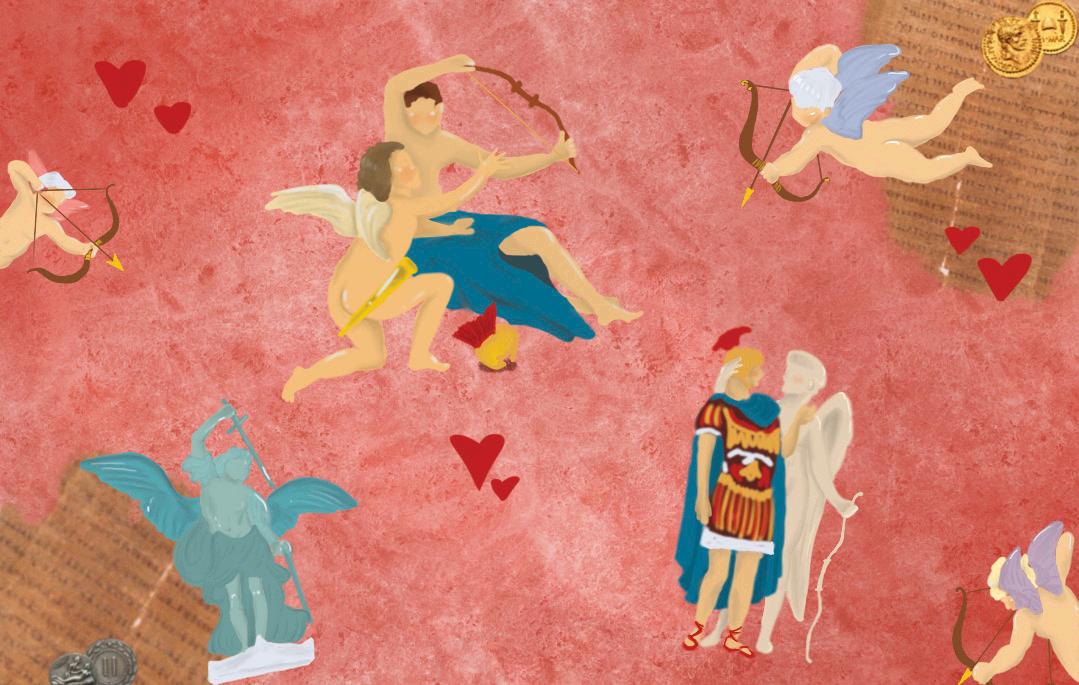
giving rite comes from one story of St. Valentine’s incarceration, led by his involvement in the escape of abused Christian prisoners. Valentine was ordered to be executed on February 14, writing his love — rumoured to be his jailer’s daughter — a note. Talk about forbidden love! He signed the note, “From your Valentine,” an iconic message used to this day, before being martyred like his fellow St. Valentines.
Valentine’s note is just as iconic as the first documented Valentine we have, which was also written from behind bars. As the common story goes, Charles of Orléans was captured and imprisoned
Let’s give short kings a chance
The benefits, and even liberating quality, of dating a man shorter than youAnna Alemany Varsity Contributor
Back when I was 16, I was in love. He was a dancer, four years older than me, suave as hell in my innocent, inexperienced eyes, and of course, tall. I’d lose my mind whenever I watched him dance to an overrated Chris Brown song and wipe his face with his shirt afterward. He was beautiful to me, even after we entered a toxic relationship. I slowly realized he was romantically incompetent, and all he had to offer was six feet of crying myself to sleep at three in the morning.
More often than not, when girls are asked to describe the physical qualities of our ideal hypothetical boyfriend, I find the answer usually goes along the lines of “curly hair, pretty eyes, and definitely over six feet.” This pattern has shown to be so strong that even dating apps have caught on; Bumble and Hinge offer height on the list of physical characteristics one can add to their profile.
This raises the question of why we, as women, are so keen on dating men taller than us. Why has height become a common prerequisite for dating any man, often trumping other physical,
and sometimes even emotional attributes?
There is potentially both an evolutionary and social answer to this. One common pop theory is that women tend to prefer taller men because they create a sense of security, seeing them as better protectors and providers of the natural resources we need for the survival of our genome.
Additionally, culturally speaking, we women have been exposed throughout our lives to rhetoric designating taller men as more desirable than their under-5’7 counterparts. Taller male love interests dominate the media. Time and time again, I turn on the television to a ’90s high school rom-com featuring a vertically-gifted jock that has all of the girls swooning. This socializes women into thinking taller men are superior in the realm of love — and that they may face shame if they choose to date someone on the shorter side.
However, despite the apparent consensus among women that taller men are preferred in the modern dating pool, there are some major pros for the world’s petite princes.
A study by sociologists at NYU found that shorter men may make better partners and have lower divorce rates. While not a lot of research
Animal skin and… fertility?
‘Lupercalia’ is a pretty word to describe a festival consisting of slapping women with animal skins. The Romans celebrated Valentine’s Day through this ancient fertility festival, a practice in honour of the Pagan Gods.
Using the stripped skins of sacrificed animals, Roman priests slapped at any woman who happened to cross their paths. Apparently, being slapped by the skin of a sacrificed animal made a woman fertile; how they decided this is a very good question. At least these women were, apparently, not fearful of the men striking at them with animal
skins. Women welcomed the practice in hopes of fertility in the upcoming year. As appalling a ritual as it is, at least it seemed consensual!
Pope Gelasius later dropped this festival, claiming the practice was “un-Christian.” Surely, this was a conclusion that was code for ‘a rather odd thing to be into.’ Although it’s an exciting method of celebrating February 14, Lupercalia would not likely pass as romantic in modern society — but to each their own!
Who’s the flying baby?
Cupid is a figure often seen in the romantic propaganda associated with Valentine’s Day, but who is he? Known as that little cherubic guy with the wings and arrows, Cupid — or Eros — was the handsome son of Aphrodite, the beautiful Goddess of love that we all know and love.
Yes, you read that right. Handsome. The flying baby was not always a flying baby. He was a handsome young man who was both sexually powerful and manipulative. The modern-day toxic dreamboy Eros was a perfect example of the ‘ick.’
Eventually, after his constant shenanigans using love to incite tragedy, his mother put him in timeout. Well, not actually. Aphrodite scolded her son, forcing him to use his powers solely for love rather than chaos. The familiar discipline only a mother could display reduced Eros’ intimidating reputation. The mortals who worshipped these gods continued to infantilize the figure we now know as Cupid, ensuring they would be safe from his wrath as long as he was still powerless against his mother.
It’s cringe-worthy, almost. There is nothing wrong with being a momma’s boy, of course, but Cupid shouldn’t represent Valentine’s Day. In fact, his child-like obedience makes him more suitable to be the face of Mother’s Day!
Surely, you now realize that Cupid is a bit lame to thank for the creation of this romantic holiday. That is, unless your mother is your Valentine this year: then power to you, momma’s boys!
Despite the heart-shaped candy and the romantic propaganda, Valentine’s Day is just a bizarre, ancient joke. If you wonder what to do this Valentine’s besides wallowing in your singleness, consider walking up to a happy couple and telling them about the true origins of the day they’re celebrating! Happy Valentine’s!

exists to explain this phenomenon, some of my friends and I hypothesize that it’s because they have to work harder on their personalities and likeability to find and keep partners, to make up for a lack in height. Additionally, they reportedly do more housework and have more sex with their partners, making them perfect pocket-sized companions.
I found this news shocking when I first delved into my research on short kings after I caught myself — at 5’7 — crushing on my 5’3 coworker. Admittedly, I felt ashamed about being attracted to a man a few inches shorter. I, too, had swiped left on the premise of height before and let myself get caught up in expectations and stereotypes.
But now, after over a year of dating my short king coworker — well, now ex-coworker — I couldn’t be happier. He is the most handsome, sexy, and intelligent man in my eyes. He treats me better than I could have ever hoped for, and I still melt when he looks up at me with his lovely brown eyes and eyelashes. He sees me like a queen, and I see him like a king. My friends, though they were dubious at first about our relationship, now praise our healthy, unproblematic, and ultimately, just very normal relationship.
I think it’s time we take a step back and break away from the idea that only tall men are worthy of our attention. Let’s give short kings a chance. There’s a reason they’re called kings, after all.
Why does height, for many women, feel like it’s become the number one prerequisite in an ideal man? CAROLINE BELLAMY/THEVARSITY KATE CARACCI/THEVARSITYAttention bitter singles: some couples have managed to survive the fall breakup season and can unfortunately still be found walking around campus, arm in arm. So, here is your friendly guide on where the most notorious U of T couples frequent and where to go to avoid them!
The Varsity Athlete power couple
This couple can be identified through their matching varsity backpacks and refusal to wear anything non-athletic. Even in below-freezing temperatures, their hoodies and sneakers seem to be capable of repelling both snow and rain, leaving them looking effortlessly gorgeous.
Where to find them: This breed of couples tends to circle around the Goldring athletic centre or Varsity Stadium, so avoid sports this Valentine’s season and you should be absolutely fine.
The depressed future doctors
Anyone in life sci knows it is a loveless existence, yet some students have been able to find love even in the darkest places. This couple can be identified through their matching sweatpants and the dead look in their eyes. Their love language involves exchanging sweet sentiments via iPad notes.
Where to find them: This couple is often on campus from dusk till dawn and can be located primarily in Gerstein Library and Robarts, but occasionally they can be spotted walking hazily over to the food trucks for a quick pick-me-up!
The library lip-lockers
It appears that the couches of Robarts have one function — romance — and this couple takes advantage of that. Whilst surrounded by sweaty, frantic U of T students, this couple blocks out the world to really enjoy each other’s company. They can be identified through their constant need to touch: when they are not locking lips, they are holding hands, canoodling, or laughing without a care in the world.
Where to find them: Robarts couches! This Valentine’s Day, maybe avoid Robarts altogether? It’s already midterm season, there is no need to make it harder on yourself!
The TMU himbos
If there is someone that looks far too cool to be at U of T — spoiler alert: they probably are! Do not fall for the trap this Valentine’s season. The Toronto Metropolitan University (TMU) himbo can be identified by their tattoos, effortlessly cool indie style, and zen aura. But be warned, singles: they have been claimed; if they are wandering around like a lost puppy, know there is a U of T mama bear looking for their cub.
Where to find them: The TMU himbo can often be found lurking outside popular U of T buildings waiting for their significant other; they are often seen smoking, skateboarding, or accomplishing something artsy and cool. Do not approach!
The Woody Allen enthusiasts
This couple would like to remind you that they
The first time I suggested using a sex toy to my current boyfriend was only four days after we agreed to be exclusively together. We had known each other for months, and he knew how much I cared about a healthy sex life, but we had only slept together a handful of times. Up until that point, I hadn’t finished with him, and I had let him know that this was normal; I hadn’t been able to do so up until that point with anyone at all.
He understood, but I imagine that’s a hard thing to hear. How do you handle hearing your partner needs a sex toy to feel pleasure? How do you fully understand how something that came so easily for you can be so difficult and calculated for your partner?
At that moment, I could feel his discomfort when realizing that this time wouldn’t be a miracle, where somehow he would suddenly overcome my obstacle with no practice or communication. I felt ashamed because I felt like he wasn’t hearing me, despite my insisting that I needed extra help orgasming. The last thing I wanted going into our relationship was to have him internalize this problem and think that my not being able to orgasm without the use of a toy would make him less appealing, which was never the case.
I can’t claim to know firsthand how that initial shame feels for the ‘other partner,’ — realizing they can’t make their partner reach the finish line without using toys. If I had to guess, it probably feels like failing. As a society, we have placed so much value on the sexual prowess of men in our society that when they realize they have to work for it and practice to become good at sex, they deflate. Even as their partners, we romanticize this idea of a man inherently amazing at pleasuring us, to the point

are ‘not like other couples.’ This bisexual power couple is cool, trendy, and always dressed to the nines, with a look that says they will step on you if you get too close. They can be identified by their multitude of piercings, and style straight out of an indie magazine — but don’t worry, it’s all thrifted!
Where to find them: Hart House is this couple’s stomping ground, so be sure to keep the words Shein and TEMU out of your mouths if studying here.
The daddy’s money duo
Last but certainly not least, this couple is rich, and they want you to know it! They can often be seen in matching Louis Vuitton, with Apple watches on display and Starbucks cups in hand. But be warned: their refusal to walk single file may force late students onto the road if one wishes to overtake them.
per cent of those men reporting usage dur ing intercourse. While their reasons for using one might vary from experimentation and en joyment to obstacles like mine, rest assured that using sex toys is more common than you think.
Where to find them: While this couple cannot be localized to one specific on-campus area, avoid Philosopher’s Walk en route to Yorkville. This couple loves to shop and dine out, and this Valentine’s Day, the gifts will be flowing. If you encounter this couple on Valentine’s Day, do not be surprised to spot them holding an extravagant bouquet or shopping bags from Tiffany’s!
If seeking solitude this Valentine’s Day, there is only one area guaranteed to be couple-free: the Bahen Centre. Its fluorescent lights, lack of colour, and general sense of misery are the perfect antithesis of romance. While you’re there, remember to wave hello to other lonely singles!
But mostly, remember to enjoy U of T’s one true love: midterms, which will provide a lot of late nights, intense quality time, and a few tears. But, hey, at least there’s chocolate!
where even we feel a little disappointed when he’s not all that right off the bat.
I like to talk openly about my use of sex toys because navigating sexual obstacles is harrowing. I always think of the degrees of shame he must’ve felt. So much of our sex education comes from our peers, overproduced and unethical pornography, or men on podcasts that we forget sex is a skill you have to learn through practice. We tell men that there must be a certain way for them to sexually fulfill us. And when the teacup shatters? When they realize most women cannot finish from penetration alone — yes, even if it’s big — they’re overwhelmed with shame.
Initially, despite understanding what my body needed, it felt bad to be using “unnatural” ways to reach an orgasm. No amount of googling and reassurance from the internet calms you down when you begin to overthink, even if you read that 37 per cent of women use sex toys with their partners during intercourse. What if I never orgasm the way ‘nature’ intended? What if I never get over this mental block? What if he leaves me over this issue because he thinks I don’t find him attractive enough? It can be so easy to take on a mindset of fear and insecurity in similar situations.
Sex toys are a godsend for girls like me. Once you’re over that original obstacle of shame, they bring variety, excitement, and re assurance to a monogamous long-term rela tionship. If we both had to worry every time we had sex, our relationship would break under the weight of shame. If anything, I have only introduced more types of sex toys to my rela tionship, venturing into toys designed for men and couples as well.
A 2010 survey published in the Journal of Sex & Marital Therapy recorded that about 44 per cent of heterosexual men had used a vibrator at some point in their lives, with 82
I think we expect sex with someone else to feel like sex with ourselves, but that would be a mistake. We shouldn’t expect someone else touching us to feel like we are touching our selves. No one body is like the other, and we all have our unique preferences on how to be touched.
I’ve learned that even though you know your body, you sometimes just don’t have the words to describe how you enjoy things. I could sit there and use words like “gentle,” “circular,” or “flat,” but once you’re out of buzzwords you’ve read online, there’s really no other way to show your partner how you like it. Sometimes, I feel like we ex pect a new partner to automatically know things we’ve learnt through patience, time, and experimentation.


Until then, a sex toy introduces a reliable constant that does not change based on mood or energy. It allows you to experiment and learn about each other’s bodies without feeling the urgency of a failed sex life. We may want to hide our sexual obstacles because we think they’ll be too



not easy being a “good girl”
As a humanities student whose syllabi brim with overwhelmingly man-authored reading lists, I am always eager for when a winter or summer break rolls around and I can devour literature by women — a refreshing change. Among this past break’s reads, Anna Fitzpatrick’s human and humorous Good Girl was by far my favourite, and the most memorable of them all.
Good Girl follows Lucy Selberg, a 25-yearold woman in Toronto who is at odds with her sense of self. When the novel begins, Lucy is a writer who isn’t writing, works at a bookstore, and is hellbent on finding a man to fulfill her kinky dreams. Aimless and insecure, Lucy is desperate for someone to guide her through life and tell her how to be a ‘good girl,’ both in her actual life and in the bedroom.
Since reading Good Girl I have been itching to share what I find special about it. Fortunately, I was able to speak with the author herself to enhance my understanding of what makes Good Girl so darn good
I had been familiar with Fitzpatrick’s work from her days writing for Rookie, an online magazine for teenage girls, which inspired my own adolescent aspirations for journalism. Fitzpatrick is a Toronto-based writer from Ottawa who attended York University Glendon Campus for English literature. She started a blog in high school, where she wrote about fashion, film, art, and culture.
Fitzpatrick hadn’t intended to write a novel,
but in 2016, while living in Budapest, she felt qualmless. “I had rented an apartment in a country where I knew nobody and had no obligations,” she told me. “I started writing one scene, thinking maybe it could be a short story.” Over time, a personal project became a novel. “I don’t know if I would have started if I knew it would turn into a novel. There was no pressure for it to be anything, so I just kept writing.”
Contrary to popular assumption, Good Girl is in no way autobiographical. Though Fitzpatrick and Lucy share “biographical details,” she said, Lucy is “a fictional character with her own experiences.”
What struck me about Fitzpatrick’s storytelling in Good Girl was her cleverness in not swaying the reader to pick one moral argument over another, instead forcing us to look past the black or white and into the grey intersection of feminism and sexuality. The protagonist Lucy often uses her political values to justify her pursuit of BDSM — bondage and discipline, dominance and submission, sadism and masochism.
“Lucy has this idea of what sex positivity looks like,” wrote Fitzpatrick in a message to me. “She became an adult in an era where feminist rhetoric would be pushing back against slut shaming.” Though Lucy is entitled to her pleasure, she tends to overlook the fact that sexual desire is complicated. Just as Fitzpatrick confronts us with these ambiguities, Lucy learns to be wary of the wavering line between fantasy and reality.
In many ways, Lucy uses her submissive personality to excuse herself from responsibility;
she believes that it places her at the mercy of others, unaware that her actions have an impact, which creates problems in her relationships. Early in the novel, Lucy is in bed with a date and displays her ironic brashness as a submissive, imposing her fantasies onto her date. After she dismisses his efforts to slow down the sexual encounter, he stops it altogether.
Fitzpatrick drew attention to this scene to show that “there’s a huge gap between knowing what you want and knowing how to get it, especially when what you want involves another person with their own desires and boundaries.” Regardless of her passive role, Lucy is an active participant in the sexual encounter, which comes with mutual responsibility.
In platonic relationships, too, Lucy seeks strong personalities by whom she can be led. Her best friend Sasha’s assertiveness and confidence draw her out of her shell but also place Sasha on a pedestal — causing Lucy to neglect that, sometimes, Sasha also needs guidance from her friend.
However, just as Lucy imposes her submissiveness onto others, she does so on herself. In her relationship with a fellow writer named Malcolm, whose fantasies align with hers, she finds he often subjects her to intense sexual scenarios without warning. “There can be so many moments during sex,” explained Fitzpatrick, “where things can be pushed to the point of discomfort even though everyone has technically consented.” Instead of respecting her unease, Lucy endures it as part of her role. She won’t allow herself to say no.
Part of what distorts Lucy’s understanding of consent is her fixation on BDSM representation in the media. She adores the film Secretary, an erotic film about a submissive secretary who begins an affair with her boss. What Lucy must remember is that movies and porn are entertainment, not instruction manuals. By the end of the book, Lucy reads the short story “Secretary”
by Mary Gaitskill, which influenced the movie, and realizes how the true multifacetedness of its characters complicates their psychosexual dynamic — a layer that the film glosses over.
Good Girl offers a reflection on how commercial and aestheticized sexual dynamics in the media complicate our desires, values, and views. For a generation whose consumption of sex and romance often precedes first-hand engagement with either, it is essential to consider that line between fiction and reality.
Fitzpatrick defictionalizes fiction by highlighting these contradictions, rather than paving over them. She complicates definitive ideas of feminism, consent, autonomy, and desire, and forces us, along with Lucy, to look inward and recognize the paradoxes of being a ‘good girl’ in a real, demanding world.

Content warning: This article mentions sexual violence and torture.
The ’60s and ’70s were a fascinatingly horny period for Japanese cinema. Just a decade after the first kiss was shown in a Japanese film — which was coyly obstructed by a strategically placed umbrella — hot babes were suddenly available on every screen with their legs spread wide open, signalling a shift in cultural attitudes. The explosion of borderline-pornographic films produced during this era is called ‘pinku,’ or ‘pinky cinema’ — a deceptively cute name for the salacious genre.
The term ‘pinku’ covers a wide range of Japanese theatrical films that first emerged in the 1960s, which deal with extremely sexual content. Much like the ‘sexploitation’ phenomenon in the US, pinku films were typically lowbudget, B-grade movies produced by small studios. Although they ostensibly revolved around a plot, the main allure of pinku was titillating displays of flesh.
Despite their lecherous premise, some pinku films are surprisingly rife with leftist politics and subversive gender dynamics. Shunya Itō’s Female Prisoner (1972–1973) series, for example, channels its progressive message through Matsu (Meiko Kaji), a cunning woman who is betrayed and imprisoned by her former lover, a crooked cop. Refusing to stay subservient — as so many women are conditioned to — Matsushima literally grits her teeth and perseveres through carceral injustice in hopes of one day gutting her ex.
Her body is put through excessive labour and torture, testified to by grotesque scars that run across her curves. Despite the sadistic games played by men prison guards and the scathing remarks from her fellow inmates, Matsushima is unwavering; each time she is touched and abused, her pretty brown eyes turn toward the
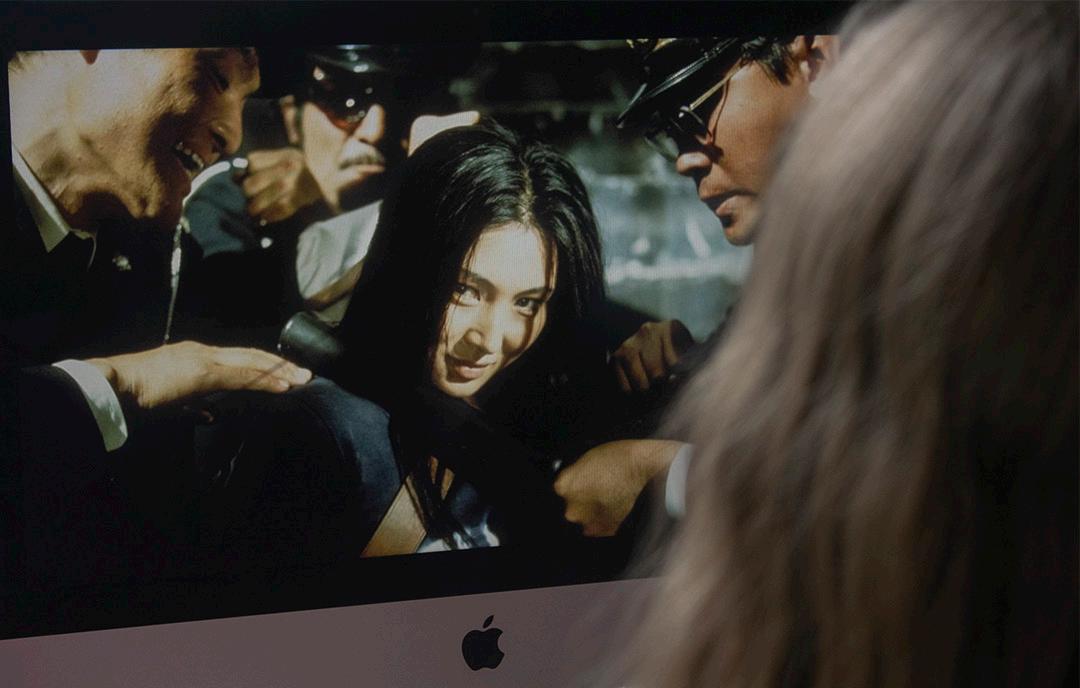
camera, petrifying the characters who assault her — and us, the audience, by extension — with a low-lidded, seething glare.
Hers is an oppositional gaze so sharp that any viewer’s skin would pebble and stomach lurch. Perhaps, as much as looking is an exercise of subjugation, it can also be a form of resistance; to lock eyes with your rapist, matching his objectifying dead stare with a look pulsating with repulsion, is profound. For a society where demureness in women is held in high regard, Matsushima’s defiance spits on Japan’s traditional gender roles by refusing to let anyone dominate her spirit.
Norifumi Suzuki’s Sex & Fury (1973) is another interesting case of politics being used as a vessel for visual pleasure — or perhaps the other way around. Starring hard-edged Reiko Ike as Ocho, the plot follows her quest to avenge her late father, who was murdered in a supposed mugging.
Notable is the inscription of Bushido values in Ocho’s character. Touting courage, determination, and self-sacrifice, the samurai code of
conduct has informed modern Japanese society in very gendered ways. For a woman such as Ocho to embody it to its fullest, through her steadfast filial piety and righteousness, makes a statement that the strict division of gender roles is a little bit more malleable.
Suzuki’s push against gender is paired with an explicit anti-imperialist critique of Western money in the form of a beautiful British spy named Christina (Christina Lindberg), who travels to Japan to corrupt politicians and steal military secrets. Suzuki is not shy with his nationalism here. The British characters are depicted as snooty individualists who infect Japanese society with their ‘otherness.’ This difference is accentuated by the stiff tailored suits they wear, in contrast to Ocho’s flowy kimonos. Clearly, these images are intended to accuse Britain of its history of imperialism in East Asia during the Meiji period.
Itō and Suzuki’s work feel remarkably empowering — until, eventually, a woman character strips naked for no particular reason, or makes sensual noises while completing the
most banal of chores, reminding us once again that we are watching porn directed by a man, and not a dissection of women’s sexuality by Catherine Breillat. Pinku is interesting for this exact reason. The constellation of complex and provoking political themes and sexploitation are hard to reconcile at first. Contradictions define the genre — even the name ‘pinku’ connotes innocent femininity, which is absolutely not the case.
The tensions of pinku intensify when considering the practices. Pinku theatres, much like Toronto’s sketchy porn shops, used to be everywhere in Japan’s red light district. With the content mainly catered to men’s lust, it is unsurprising that viewers were predominantly men — I can only imagine the small cramped rooms filled with a strange pungent odour. Women rarely sat in the audience, and if they did, the erotically charged space meant they faced many unsolicited gazes or touches. Ironically, then, the gendered subject of these tales of empowerment and sexual liberation was alienated from the very films they were supposed to identify with.
So how should we think about the politics of pinku? Is its sleazy imagery merely a marketing ploy intended to draw audiences into the political orbit? Or, more convincingly, do its politics provide a cover of respectability to detract from pornography’s ‘low brow’ status?
Despite these complexities, it would be silly to completely dismiss pinku. The existence of this genre is itself subversive. In contrast to the state’s decidedly Puritan vision for postwar Japan, based on innocence and heteronormative divisions, these films encouraged the nation to indulge in its sexuality. Radical desires and unabashed yearning marked the pinku project. After the despicably savage Second World War, the pinku genre demonstrated that the path to moving forward wasn’t through sterility and innocence but in acknowledging and embracing society’s own baseness.
In the fiction section of every bookstore lies a towering shelf of Harlequins. This cascade of erotic romances, synonymous with glossy covers, provocative plots, and on-the-nose titles like In Bed with the Boss — yes, that’s a real book — are the unsung heroes of airport bookshops.
Although Harlequins are generally thought to be most popular with older women, platforms like Tumblr, Wattpad, and most recently TikTok have brought in a new generation of interest towards erotica. Like its predecessor, this new wave of erotica has its own set of tropes.
The content of a Wattpad romance novel is often so closely in adherence with its own set of cliches that the cliches themselves have become a sort of formulaic genre system. Examples include the “enemies-to-lovers romance,” the “fake dating trope,” and even the sensationalist “mafia romances.” While Wattpad, Harlequin, and similar popular romance novels can be fun, they often present trite, highly commercial plots.
This is not to disparage romance as a genre, which has historically catered to women, but rather to explore beyond the modern Wattpad romance into genres of literary romantic fiction with notable authorship.
This exploration into the literary romance genre explores books with broader scopes and nuanced writing — still appropriately salacious but with an examination of desire in the context of social complexities and evolving interpersonal relationships.
The classics: Delta of Venus, Little Birds, and the evocative Anaïs Nin Anaïs Nin’s erotic memoir is a linchpin in the development of the transgressive, modern writer. Nin writes not only about the physicality of sex but
also about its ability to be a vessel to craft narratives from unorthodox and provocative experiences.
Nin’s memoir discusses the zeitgeist, psychology, and celebrity culture of the ’60s. Her short stories in Little Birds and posthumously in Delta of Venus are staples amongst modern works
expatriate writers in the Parisian underworld carry a hedonistic, unhurried quality, creating a sensual mise-en-scene that eclipses even the most explicit scenes.
Similarly, James Salter’s A Sport and A Pastime explores an American expat’s relationship with a French woman — perhaps a trope of its own — with writing so intricate, so abrupt, and yet so tactful that it can only be compared to Ernest Hemingway. Pastime’s unnamed, unreliable narrator, separate from the central lovers, weaves their clandestine memories of the two with expressions of their own longing. Salter’s understated writing makes this a personal favourite.
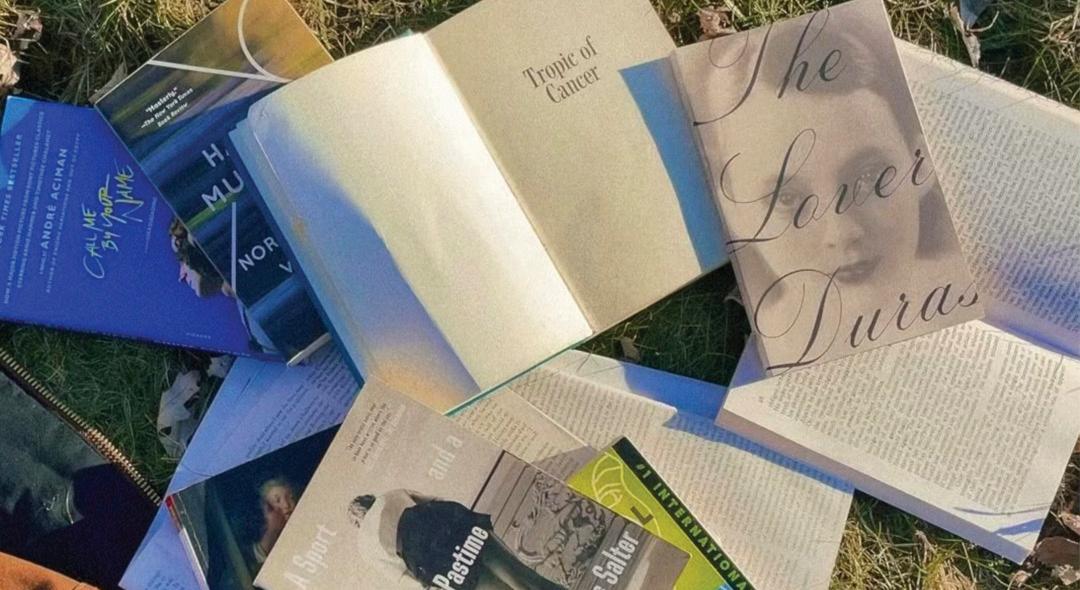
unveiling women’s desires. Each story is highly evocative and filled with lush, poetic prose on gender politics and sexual identity. Despite their controversies upon release, Nin’s works are now a touchstone to the erotica genre.
Navigating desire for the modern milieu: Henry Miller and James Salter Henry Miller, like his collaborator Anaïs Nin, experienced no shortage of controversy when he published Tropic of Cancer; Tropic’s working title — Crazy Cock — can attest to its supposed obscenity for its 1934 debut. A thinly veiled semiautobiographical narrative, Miller’s descriptions of
The classic musical got a major marketing budget. Did it pay off?
Sulaiman Hashim Khan Comment ColumnistLike rama lama lama ka dinga da dinga dong. As shoo-bop sha wadda wadda yippity boom de boom. No, you haven’t spontaneously developed a case of dyslexia — I just have a song stuck in my head.
From February 8–10, Trinity College Dramatic Society (TCDS) presented Grease the Musical: the everybody-knows-it show about a group of rowdy teenagers in 1950s Chicago as they navigate high school — and each other. Directed by Luis Sanchez and staged at the Hart House Theatre, this production brought the classic musical to U of T with the goal of tapping out the essence of the play as a raunchy parody of 1950s Americana.
The musical follows Danny Zuko (Joseph Chiu), a member of the T-Birds gang, and Sandra Dee (Serena Barr), the sweet new girl at school, as they are reunited after a summer fling and face the dramatic dynamics between their friend groups. These friends make up much of the rich cast of supporting characters like Kenickie (Benjamin Rosenberg), the unforgettable chain-smoking owner of the coveted car Greased Lightnin’; the coleslaw-craving Jan (Kiara Accurso); and the insatiable Sonny (Spencer Pearson).
Uniquely for a student-run play, Grease had hired its own marketing team. The play had a media photoshoot and was even performed on a separate night just for the press, “which no one has ever done,” said Sanchez, in an interview with The Varsity. “Just a lot of bigger things that required us to [step out] of our usual purview.”
The license to put on Grease is difficult to acquire. Between that, the size of the venue, and all the elaborate props and accessories that went along with staging the show, “to make our money
back, we had to really focus on marketing,” said Sanchez. This comes as no shock to anyone who’s been to U of T for the past few months.
Flashy posters for the musical covered pretty much every wall and corkboard on campus. Sanchez mentioned the Friday night show sold out, and other days came close.
We’re more than half a century removed from the era of Grease, and there’s something charming and nostalgic about the show, with its outlandish concepts and characters; as Sanchez said, “Everyone in this play is kind of an asshole.” This was a particularly fitting remark, as viewers were exposed to a whole lot of ass and underwear.
“What people don’t realize is [this is] a parody,” said Sanchez. The trope of the time was that stories ended with the good girl taming the beastly, chauvinistic bad boy — a cultural evolution of the Beauty and the Beast archetypal story. “But in [Grease], it’s the opposite.”
I must emphasize the general cohesion and chemistry between the entire cast and ensemble that worked as a truly well-greased machine. Larger scenes, such as those featuring the entire Pink Ladies clique with their fast-paced dialogue and shrill shrieks, felt natural and without exaggeration. Still, I do wish that the Ladies’ mics were calibrated better, as it was difficult to make out exactly what they were saying with such fervour.
Jessica Wang as the adorable Frenchy and Shunsho Ando Heng as Doody were easily the best romantic duo — beyond their limited verbal interactions, the players’ silent background interactions and physical work with each other brought authenticity to their on-stage relationship.
This leads to what was perhaps the most devastating aspect of an otherwise wonderful production: I could not believe that Sandra or Danny
of the three novels.
In a part-epistolary, part-novelistic fashion, Rooney ruminates on broad topics such as love, class, and climate change to the more esoteric, like the purpose of aesthetics or the history of the Bronze Age. Though the characters are gravely aware of the world at large, there is no postmodernist angst within them; Rooney’s characters meaningfully search for connection with the help of her romantic dialogue and witty, irreverent prose.
André Aciman’s lyrical, introspective writing in Call Me By Your Name (CMBYN) similarly explores young love. CMBYN’s protagonist’s rich inner life depicts self-discovery, art, and the transience of time through his love affair. Lush prose renders the Italian villa where the characters reside; the protagonist’s relatable inaction to love is portrayed with tenderness.
Literary memoirs: Annie Ernaux and Simple Passion
It is no surprise that Annie Ernaux’s magnetic prose and highly introspective memoirs won the Nobel Prize for literature in 2022. Ernaux’s prose is unflinching and honest; her direct style is a reminder that she pens unembellished stories. Despite the austere quality to her writing, Ernaux’s Simple Passion is sensual and heartbreaking, depicting her affair with a married diplomat.
The contemporary: Sally Rooney’ and André Aciman
Sally Rooney, once described as the “Salinger for the Snapchat generation,” closely writes about the complexities and foibles of young relationships. Like everyone else, I found myself predictably obsessed when Normal People was released.
Though her two previous novels — Normal People and Conversations with Friends — were praised for their sensitive portrayals of young sexuality, Beautiful World, Where Are You is a testament to Rooney’s growth, depicting matured relationships, and it is, by far, the most salacious
wanted anything to do with each other. While a great deal of the play rests on the fact the two are somewhat ashamed of their relationship, and Danny particularly wishes to shun Sandra in front of his friends, it still seems that they might’ve been lying when they sang “We Go Together” — and no amount of hair gel can fix that.
While Barr and Chiu shone on their own and embodied their roles within the ensemble, it was particularly heartbreaking to see how artificially they appeared in front of each other during scenes that focused on them as a pair. I could not believe that Danny was devastated about being “Alone at a Drive-in Movie,” despite Chiu’s powerful vocal performance.
I could not get enough of Rosenberg, however, who felt like he was plucked straight out of a 1950s Greaser gang with his shivers and mouthy
Her understated writing on love and obsession is nearly radical; Ernaux’s prose takes our universal experiences with love as a topic worth contemplation without any wry cynicism. She serves as a comforting revelation that amid the complexities of our shared human experiences, there is an innate understanding that says, “It’s all going to be okay.” Her narrative offers solace in the intellectual embrace of our collective emotional experiences.
The works above invite readers to explore romance and desire as a facet of the human condition. While bodice-rippers are uniquely amusing — so much so that I still take a peek at that Harlequin section — intricate storytelling elevates the discourse around desire, prompting us to reflect on our connections in a world where love is a constant theme.
accent. Roger (James Goldman) and Sonny left us feeling like we all needed to go to confession. I do not think there was a scene more sincere and well-acted than Rizzo and Marty’s secret-sharing moment, played by Deslyn Bach and Kylee Martinez, respectively.
The vocal performances all around were nothing less than lovely. I cannot express the masterfulness of the doo-wop “Beauty School Dropout” we got from Hunter Gowan’s portrayal of the Teen Angel. And it would be wrong not to address the brilliance of the lighting, set, and other visual design that gave the musical its very own identity and seamlessly shifted the stage from the school gym to the garage to a back alley rumble.
In conclusion, I need to buy some pomade. And maybe I should finally get my driver’s license.

I’ve never felt as safe and secure as I did in this sex club I went to a sex club for the first time, and it was quite wholesomeKyla Cassandra Cortez Deputy Senior Copy Editor
Content warning: This article discusses eating disorders.
The discreet black door with the little keypad is wedged between a residential condominium and a convenience store. I stand still for a minute and begin questioning myself: should I go inside or turn around and leave?
My risk-seeking brain tells me, “Yes, go inside,” while my hopeless romantic heart screams, “What the fuck are you doing?” With all the self-made noise suffocating me, I decide that I am not going to live on what-ifs — so I listen to the former.
I take a deep breath and finally open the door.
A well-lit hallway welcomes me, and the white walls lead me to the left, where I face a counter that has glass panels with a staff member behind it. They smile at me as I walk in. They greet me, politely ask me for a valid ID, and then they buzz me in.
This is Oasis Aqualounge, a sex club located in downtown Toronto, on the corner of Mutual Street and Carlton Street. It hides its activities
their region or country. Depending on a person’s hometown, sex education in some schools lacks context regarding various cultural connotations and the psychological dimensions of sex that involve emotional connection.
For example, Ontario’s sex education curriculum includes teaching sixth-grade students about the impacts of watching pornography and the importance of sexual consent and communication. Meanwhile, in countries such as the Philippines, Mexico, and Italy — which have a predominantly Catholic population, a dominantly patriarchal society, and a strong purity culture — a curriculum for comprehensive sex education barely exists, or educators shy away from the topic.
For teenage girls in these conservative environments, the only free and accessible resource to find out what sex is and what it looks like is through the internet — whether it is social media, movies and television shows on streaming sites, Wikipedia, Wattpad “smut” novels, or pornographic sites like PornHub.
Admittedly, I was one of those girls. So, when I first heard of Oasis, I assumed it would be a full-blown orgy. I imagined people participating in all kinds of sexual activities left and right, whether it be with partners or in group settings
never felt so safe and secure in my own body and mind in my entire life.
Before my experience at the club, my sexual partners were often dishonest with me, making me think that they were interested in me apart from sex, which led to my early sexual experiences being motivated by their pure lust under the false guise of love. Oasis, on the other hand, showed me that sex didn’t have to be full of lust, lies, and perversion — it can be an activity that genuinely connects two vulnerable people physically and emotionally.
Honesty and boundaries
As I enter the main area, I listen to the staff member’s instructions. The establishment sets ground rules for everyone’s safety: everyone takes consent very seriously; you must be comfortable seeing others engage in sexual acts; staff roams around to ensure that everyone is safe and no one is recording anything; inclusivity is prioritized; no one can judge anyone’s body or sexual orientation; there are some designated spots where you cannot engage in sexual acts; and you are not required to take any clothes off.
over everything, and it made me feel secure about my environment. I became more hopeful about reaching my ideal sexual experience — but I still had my doubts.
I’ve always wanted the kind of sexual experience I read about in Sally Rooney’s Normal People — where the two protagonists, Connell and Marianne, care for each other inside and outside the bedroom, entrusting their vulnerabilities to one another and showcasing the awkward but realistic parts of having sex, like undressing in front of a partner or switching positions.
I felt like every move, every word, and every expression during intercourse was calculated.


The club’s rules lifted a massive weight of anxiety off me. I wasn’t afraid anymore about someone suddenly hurting me, taking advantage of me, or pressuring me into anything I didn’t want to do. Oasis prioritized safety and consent
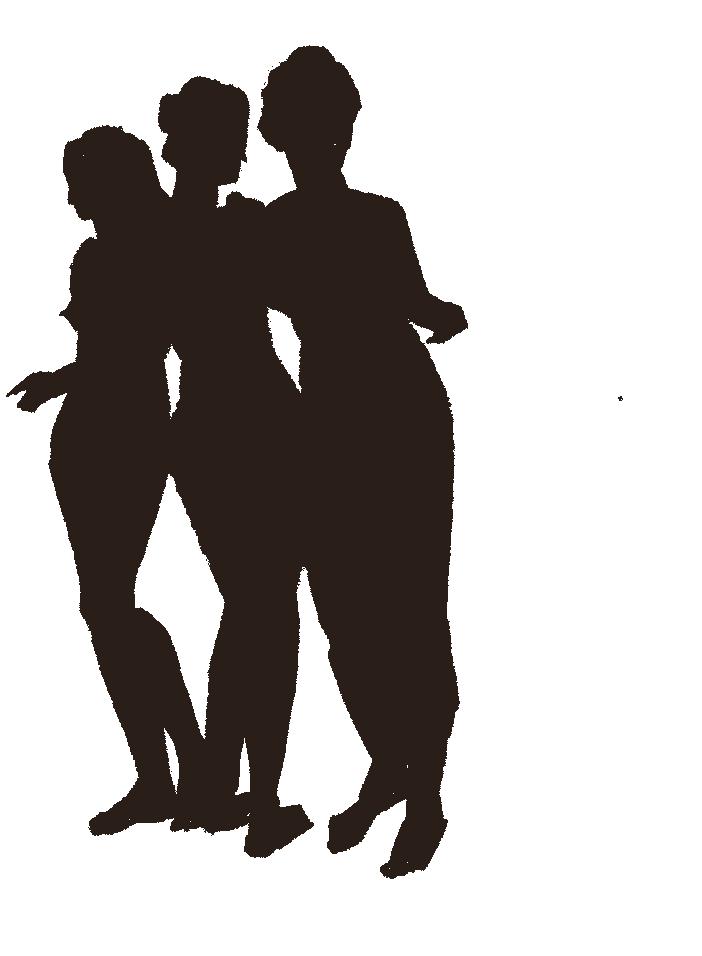

That depiction of sex has often been far from true for me. In my experience, sex usually feels performative and choreographed. In a 2019 study, it was revealed that a whopping 77 per cent of women admitted to faking their orgasms
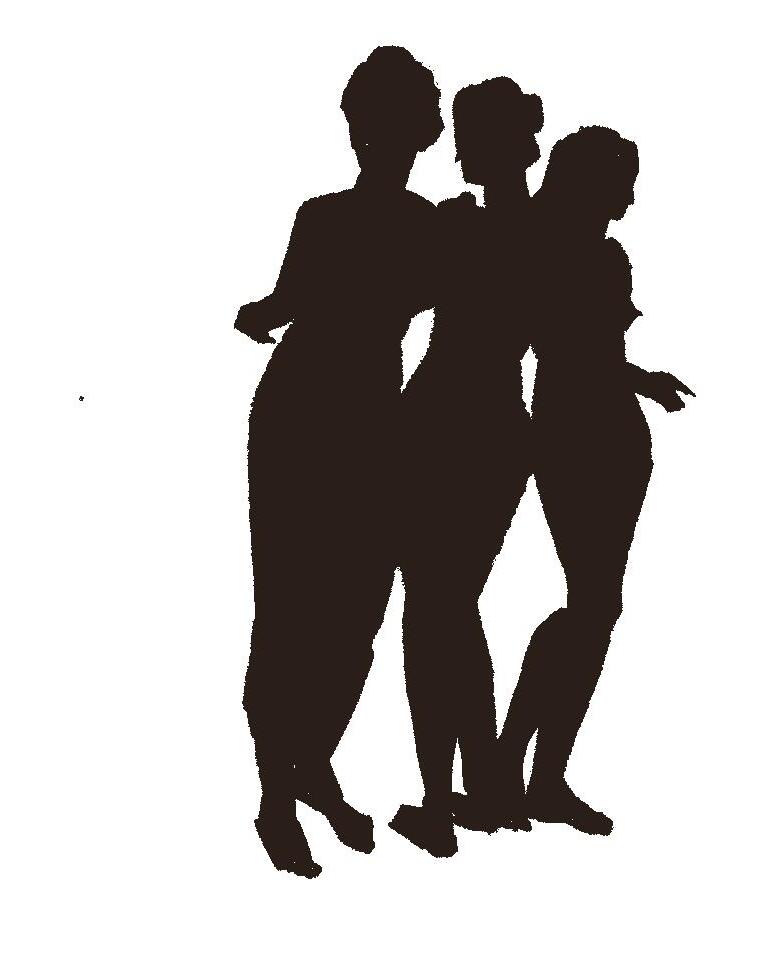



coitus never felt authentic, and for a while, I thought it was normal to not fully enjoy it.
Pornography plays a part in the notion of sex being an act, and I’ve found it ruins my intimate experiences. I relied on it to teach me about sex because, as a teenager, my parents weren’t open to talking about intercourse. Any mention of it triggered them to judge me, berate me, and demand I repent to God.
As another Oasis employee gave me a tour of the whole building, I noticed that there were TV screens on each floor playing pornographic videos on mute. While I wasn’t surprised, the videos solidified my perception of what sex feels like — a performance. I still felt like every move, every word, and every expression during intercourse is supposed to be calculated.
Body image
After the tour, I go to the locker room and stuff all of my belongings there. I undress and quickly cover myself with towels, ashamed of how my natural body looks. At that point, I begin to doubt that anyone in the club will find me attractive. Just by looking at all the conventionally attractive adult entertainers on the screens, my disdain for my physical appearance grows stronger.
A short, lean man has a locker near mine, and he apologizes for our elbows touch ing. I don’t mind at all and find it sweet that he said sorry for such a menial thing. I say that it’s okay. Once he leaves, I look at my body and think to myself, “He’s cute, but he probably wouldn’t go for me.”
Hearing criticism from my crushes about my body always hurt the most. I would hear them tell other people, “I would never like her because she is fat and ugly,” “She could be pretty if only she tried losing weight,” or “She’s fat, I don’t think I want that.” This lowered my self-esteem, and I firmly believed that no one would love me because of how I looked.
So, as a certified people pleaser, I did what I thought would solve my problems. I tried losing weight, hoping for someone to finally love me. Not necessarily romantically, but just as a friend, a family member, a niece, a daughter, a person. I thought that it would be life-changing, and ev
Looking back, I would have rather been fat and happy than skinny and depressed.
Did I get recognition for losing weight? Yes.
Did I get the validation I wanted at that time? Yes.
But did all the recognition and validation make me happy? No. I still cried myself to sleep every night and wished to be enough for someone else. I slowly learned that changing my body didn’t make me content, and I shouldn’t equate it to my self-worth.
When I leave the locker room wrapped up in a towel, I realize I’m the only one who isn’t nude. People are either topless or completely nude,
I slowly learned that changing my body didn’t make me content, and I shouldn’t equate it to my self worth.
and when I see that, I admire them for being comfortable with themselves. But I still don’t feel like my body is enough for this establishment, despite the nudity around me. The toxic beauty standards remain and burden me, like a heavy backpack that I can’t wait to take off.
Sex as connection I roam around the first floor, trying to find spots
the locker room floating there, fully naked. It feels weird seeing him in that state, and out of sheer awkwardness, I start walking away. When he notices me leaving, he says, “It’s a safe space, you don’t have to do anything here.”
I turn and ask if I could join him in the hot tub. He says yes.
I remove my towel and placed it on the hooks attached to the walls. My anxiety over my body heightens. I sit near him, and we introduce ourselves, I tell him my name, and he tells me that his name is Bryan*. He’s a bit older than me, a freelance contractor, and lives outside the GTA. As he introduces himself, I can’t help but look into his big eyes that are focused on mine.
“You’re cute. Is that okay to say?” he tells me. I smile and tell him it’s okay, and I said that he’s cute too. It doesn’t feel like he was objectifying me at all — it feels like he’s more interested in who I was than what I looked like.
We instantly connect, and we go up to the fourth floor, where there’s a private playroom. It starts off with gentle kisses on the forehead and caressing. He looks me in the eyes and tells me with sincerity that I’m beautiful.
To be that vulnerable with someone I barely know was scary, but throughout my time at the club, he never objectified me. When I was there, he made me feel good about myself — he never judged my physique or my double chin whenever I lay down. He didn’t want me to pretend to enjoy sex — he was eager to please me. He asked if I liked whatever he was doing, and I learned to be honest. I didn’t need to put on a facade, I asserted my boundaries, and I suddenly was able to embrace the natural feelings and sensations that arose.
We took breaks in between sex, and we got to know each other at an emotional level, which I don’t do with casual hookups. I asked him why he came to Oasis, and he said it was his safe space. It was a place for him to be himself, to not
daughter. He wants to move to Toronto, but he can’t afford it. He reminisced a lot about his past, and explained that he’s figuring himself out. He doesn’t want to date anyone at the moment, which I completely understand and appreciate. He was far from perfect, but he was honest and kind — like most people at the club, perhaps.
What we can learn
The audience at Oasis talked freely about sex — something that I believe the general public shies away from. Everyone talked freely about anything you could think of — bondage and discipline/dominance and submission/sadism and masochism, threesomes, you name it. There was no cringing or discomfort.
When I think about my past private sexual experiences with others — whether I was dating them or not — I’ve never reached that level of openness. I’d never felt safe with them, afraid that if something bad happened to me while I was alone with them, no one would believe me.
Oasis modelled my ideal sexual interaction: focused on care and mutual pleasure. While the environment was specifically curated to fulfill sexual desires, I learned what to take with me into the real world and what to ask for in future relationships — such as clear boundaries, vulnerability, and honest communication with a partner.
Bryan waited for me in the main area while I grabbed my things and prepared to leave. He gave me a final sweet kiss before saying goodbye. I traced back my steps, from the playroom to the main area to the discreet black door. I left the club fully dressed and fully content with my experience — with heightened expectations and standards for what I wanted from sex.
*Name has been changed for privacy concerns



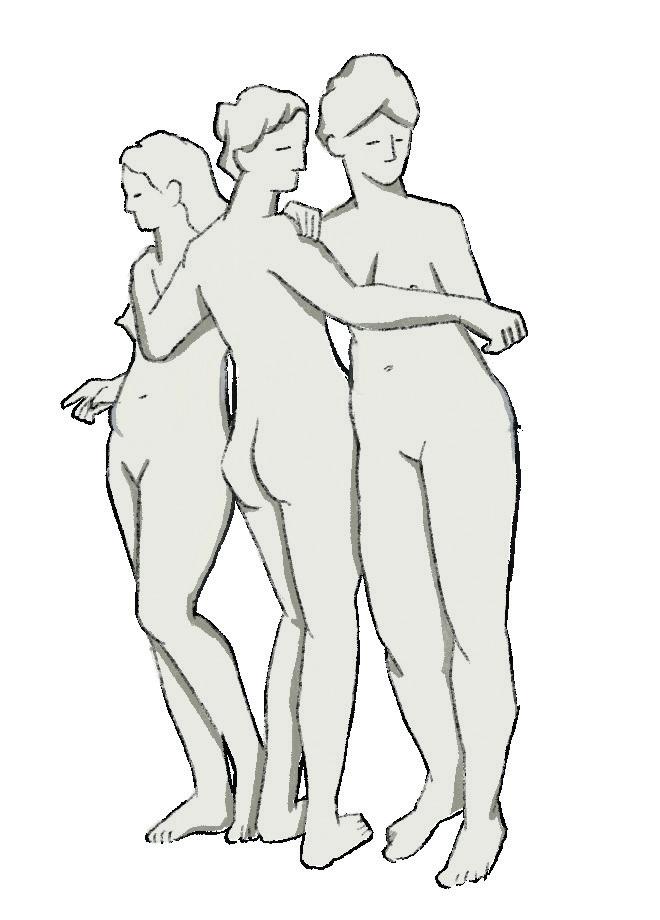



Sometimes, randomly, I raise a clenched fist and curse at the sky when I am overcome by the memory of Harry Styles wearing a dress for his November 2020 solo American Vogue cover.
In the fight for everything good in modern culture after the agony of the pandemic and the aftermath of George Floyd’s murder, that Vogue cover felt like another battle lost at a defining moment within our social conscience. As a statement, it felt and looked like consent for the reduction of Queerness to aesthetic, lifestyle, or artistic choice. It was like Stonewall for queerbaiting men and the babygirl movement; groundbreaking, door-opening, tableshaking.
There is a common, odd fascination in modern society with masculine, mostly straight men who are widely accepted as desirable and seem comfortable enough in their own skin to play with the rules of gender and its presentation through fashion choices and public personas. We have seen these men walk red carpets in bright colours, lace, and sequins, brandishing hints of makeup and glinting manicures. They have been spotted wielding Bottega Veneta purses, Vivienne Westwood necklaces, and other conventional women’s clothing. They are not afraid to smile or act shy before the camera, and they reek of a sensitivity and tenderness as crisp and tailored as the designer clothes they wear. These are our babygirls.
Harry Styles, Jacob Elordi, Timothée Chalamet, Omar Apollo, Manu Rios, a wealth of male K-pop idols, Henry Cavill, and even, apparently, Drake. We
somehow perceive them as openly vulnerable and submissive, and we applaud them for it.
I wonder why we love these men. Maybe they are simply hot, leading men in their fields of work; role models who signal security within their masculinity by inhabiting a feminine flair. Perhaps we are attracted to some real depth and complexity in their public personas or to the simple spectacle of straight-passing men performing a farce of feminine sensibilities; a fascination akin to watching a six-foot clown playing with a balloon animal or an enchanting zoo creature prowling around its cage.
What irks me the most about our culture’s obsession with babygirl men is that this fascinated desire is not extended to overtly feminine men: the gay men who came before A$AP Rocky wore a skirt and Drake put colourful clips in his hair, or the men who have suffered alongside trans women and other Queer bodies throughout history for their presentations of femininity and flamboyance.
I came to the realization that our obsession with the ‘babygirl’ man seems to have nothing to do with their tender embrace of femininity and everything to do with their maintenance of masculinity and muscularity despite of this effeminacy.
The way I see it, it is not that these babygirl men are in touch with their feminine side — but that they have mastered control over it, dominated it, and now wield it as another tool for social dominance, whether intentionally or as innocent, wellmeaning objects of mass heteronormative desire. The babygirl man and his success at getting us to worship, coddle, and infantilize him have itched my brain for far too long.
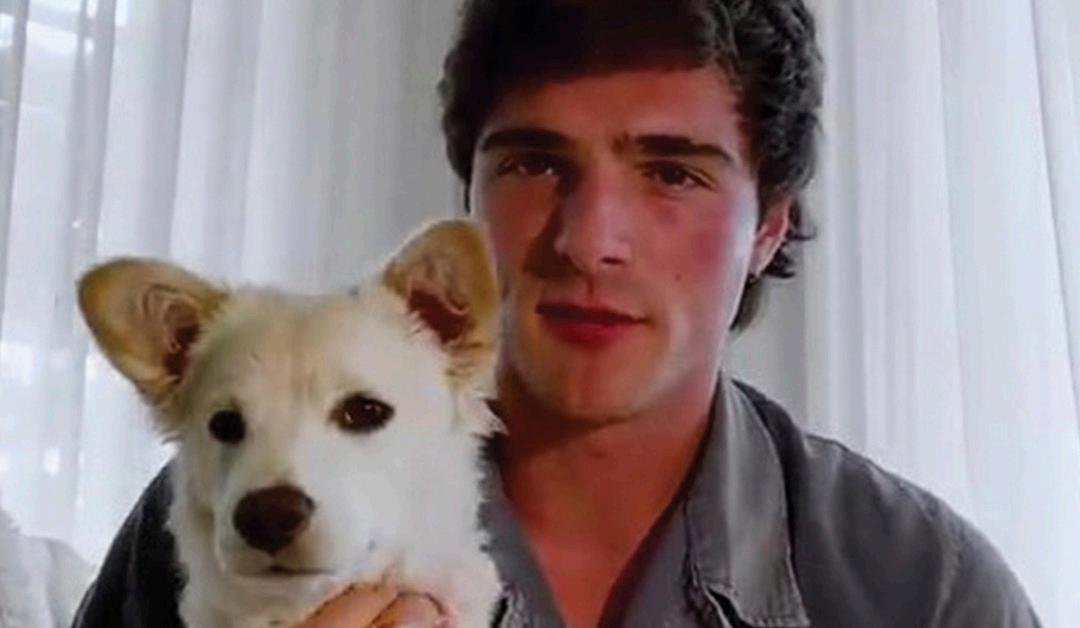
For example, in 2022, Johnny Depp was seen cuddling a badger at a rescue centre after winning the defamation case against his ex-wife Amber Heard. During the court proceedings, he was captured doodling on pieces of paper with colourful markers and showing them to his attorney like a child who expected a little treat in return. A few times, he also displayed a pile of gummy bears at his court desk too. For this, Johnny Depp was so, so babygirl.
Depp was so babygirl that his fans camped outside the courthouse to show their support. People brought live alpacas to the courthouse to ‘brighten’ Depp’s day; they tweeted about how cute he looked behind his designer sunglasses, how they wanted to hug him and tell him everything would be okay. They laughed at Depp’s fantasies of Heard’s death as punishment for calling their babygirl an abuser, and savoured her demise like good soup. They called her a gold-digger; a smug, manipulative con artist; a fake crier; a crazy bitch; a bad wife; and a turd who got what she asked for in the end. Depp’s fans stood beside him and celebrated when their babygirl emerged
victorious against the witch who tried to devour him.
In turning these men into babygirls, I believe we run the risk of enabling bad behaviour, terrible behaviour, and worse — all because we think these men are adorable, harmless projections of charm. The more we uplift this image, the more we risk erasing the stories of the people upon whose lived experience this fantasy of masculinity was constructed.
Harry Styles makes nice-enough music, has a nice-enough face, and looked nice enough in that Gucci dress on the cover of Vogue. But what did that say about the Queer people who broke down the doors of gender conformity so that a seemingly straight, white man — and an alleged ally at that — could wear their skin and walk in their shoes?
Divine Angubua is a third-year student at UTM studying history, political science, and creative writing. He is the editor-in-chief of With Caffeine and Careful Thought and a staff writer at The Medium. He is an associate comment editor at The Varsity.
Content warning: This article discusses books with graphic content.
As an avid reader, an innocent scroll through my various social media accounts usually results in my exposure to dozens of book-related videos. I often engage with posts about popular romance novels, indulging in happily-ever-afters and some of the internet’s favourite fictional male crushes, deemed “book boyfriends.”
I’m not alone in this hobby. As of February 10, 2024, the TikTok tag “#BookTok” has over 225.1 billion views. Also, interest in romance novels has surged within the past few years. In a 2023 report, BookNet Canada reported a 42 per cent increase in the sale of romance novels from 2017 to 2022.
Romance Writers of America defines a romance novel as containing two main components: a central love story and a satisfying ending. As a genre, romance has been facing criticism since its beginning, largely because it is a women-dominated genre. The misogyny involved in this presents itself through an assumption that romance novels are poorly written and in descriptions of them as “trashy” and “fluffy.” I believe that we need to keep that misogyny in mind — the misogyny that fuels the scrutiny the romance genre receives — when critiquing romance novels.
The recent increased public interest in romance novels has made me wonder how much of the criticism I’ve seen against the romance genre stems from misogyny, and how much of it carries real merit. I argue that before we criticize romance novels, we must unpack how we’re influenced by the preconceived notions we create of what a book contains based on its genre. We need to recognize
the potential inaccuracy of genres as labels — and how genres, when labelled properly, can act as content warnings for novels.
Genres may fail to indicate the contents of novels
In Romance Fiction: A Guide to the Genre, author Kristin Ramsdell addresses how genre classification is important in guiding readers’ choices. Ramsdell writes that measures other than a novel’s genre are necessary to determine its contents because, while genre is meant to be a label that indicates the contents of a novel, we cannot always rely on its accuracy as a predictor.
Consider the reception of Colleen Hoover’s novel It Ends With Us, a book categorized as “Romance” by Goodreads. Hoover’s novel depicts themes of physical, sexual, and emotional abuse. Morality criticisms across social media alleging Hoover is normalizing, and glorifying abuse in the book hone in on the fact that the abusive behaviours depicted are central to the love story in the novel.
One Goodreads reviewer, marta the book slayer, wrote, “How dare you categorize this as a romance? What about a novel that contains domestic abuse, child neglect, gun violence, suicide attempts and attempted rape screams ROMANCE to you?” Another reviewer, Ilhaam, wrote, “This isn’t a romance but half of booktok are not ready for that conversation.”
These reviews make one thing clear to me: genre matters when it comes to our book expectations.
Genres can act as content warnings
A subgenre of romance called “dark romance” reflects the significance of labelling genres accurately and how that affects our expectations of the books they comprise. This subgenre is defined as romance novels incorporating darker themes
into their plots. Characteristics of dark romance novels include morally grey characters, trauma, and violence.
It’s no surprise to me that aspects of dark romance have garnered moral criticisms. In an interview for NPR, author Ana Huang explains how dark romance fans understand many of the themes in these novels as immoral but choose to enjoy them critically regardless. Huang believes people can engage with books with content they wouldn’t condone in real life.
It seems to me that understanding what the dark romance genre entails is essential to enjoying the genre. Huang states that the content featured in dark romance would be jarring to encounter in a lighter romance novel, but that dark romance readers go into a novel in the headspace necessary to engage with darker themes. This headspace seems to entail a preconceived idea of the genre, and an understanding of the ‘darker’ themes that will be present within a novel.
In the same NPR interview, another dark romance author, Rina Kent, addresses the double standards between content made for audiences who are men and those who are women. Kent believes that misogyny factors into this because
some see dark romance fans as ‘morally incorrect,’ while the fans of horror novels written by men like Stephen King aren’t usually as scrutinized.
I believe both Huang and Kent raise important points. If readers can enter a novel with realistic and accurate expectations, I don’t see enjoying dark romance as immoral. The two authors’ arguments touch on how the only thing that differentiates dark romance novels from crime and horror novels is the romantic aspect that is expected to draw women readers. I see this to be clearly connected to the misogyny inherent in the condemnation of romance novels.
In criticizing romance novels, I believe it is important to acknowledge readers’ pre-existing perceptions that stem from both misogyny and the ways genres can fail to indicate content. This isn’t meant to absolve all romance novels of criticism, as I believe conversations surrounding the normalization and glorification of abusive and violent behaviours within the romance genre are important. However, I think it is worth assessing our biases when we analyze the morality of a novel.
Alia Eiras is a first-year student at Victoria College studying social sciences.

Content warning: This article contains descriptions of sexual coercion, sexual violence, and cultural norms that promote sexual violence.
Let’s start off strong: you meet a guy. Maybe it’s at a bar or on the street, in the meet-cute of your dreams, or it’s just pure lust. Whatever. The important part here is that eventually — 40 minutes, a week, or a month in — you have sex.
And the sex is good! Maybe even great, if you’re lucky, but there’s just a bit of a problem: he put his hand around your throat without asking. And then you had a sore neck for three days after. And he hit the “wrong hole” about four times after you said it was the wrong one. And now he won’t stop talking about anal like it’s a natural progression of a sexual relationship. He might even go so far as to say “You’re pretty vanilla” in bed, as if “vanilla” constitutes a category of sex that is different from plain old sex.
Stigmatize vanilla sex, play into patriarchal relationships
Whatever your experience, I believe there is an undeniable stigma that the word “vanilla” holds in the context of sex. ‘Vanilla’ and ‘vanilla sex’ bring connotations of boring, plain, and uninteresting. There are TikToks of people claiming that they pretend to enjoy ‘vanilla sex’ with their partners while secretly thinking about how uninteresting it is.
On the other hand, the word “freak” is thrown around as a token of praise toward a sexually adventurous or promiscuous woman. Some men claim they want a “lady in the streets, freak in the sheets” — a statement that I see as likely implying that a woman should uphold herself to traditional ideas of femininity in public, and even ‘act out’ the idea of free will or personhood, but, in private,
conform to the fantasies of the person who is ‘really’ in power: the man. By imposing this expectation on women, men reinforce that what they truly want is a woman who will, at the end of the day, bend to their sexual power and act how they want in bed.
I see many women in both my personal life and in the media push themselves past their comfort zones to pander to male sexual fantasies of the perfect, submissive woman in an attempt to escape the label of ‘vanilla.’ The Guardian reported on a sex educator’s Instagram poll being plagued with responses such as, “I don’t want to disappoint him, I don’t want to be bad in bed.”
The way I see it, stigmatizing vanilla sex plays directly into the hands of the patriarchy and normalizes women’s sexual subordination, with violence and the male gaze as the tools to enact this subordination. So, what is the root issue of this stigmatization?
Women’s sexual liberation in the hands of men I posit that this phenomenon directly corresponds to how the women’s sexual liberation movement
has been co-opted by men. In one article, PBS reported on the American sexual revolution of the 1960s and how the movement, due in part to the increasing availability of contraceptive methods, put forth the idea that “single women had the same sexual desires and should have the same sexual freedoms as everyone else in society.”
While that idea still stands today, I believe the patriarchy has taken this idea to mean a constant supply of sexually available women that men can be serviced by. As writer David Quinn puts it in The Times, “The only sexual rule today is ‘consent,’ and men have been taught that women are potentially always sexually available because that is what ‘liberation’ means.”
I think this patriarchal ideology, coinciding with the ever-increasing accessibility to porn, is creating an environment that feeds women the message that they must be okay with a man’s sexual preferences — including those that are rough or violent in nature — to be sexually liberated. After all, if you are not comfortable with that, there is always another, more willing, more liberated and less ‘prudish,’ less ‘vanilla’ woman to take your place.
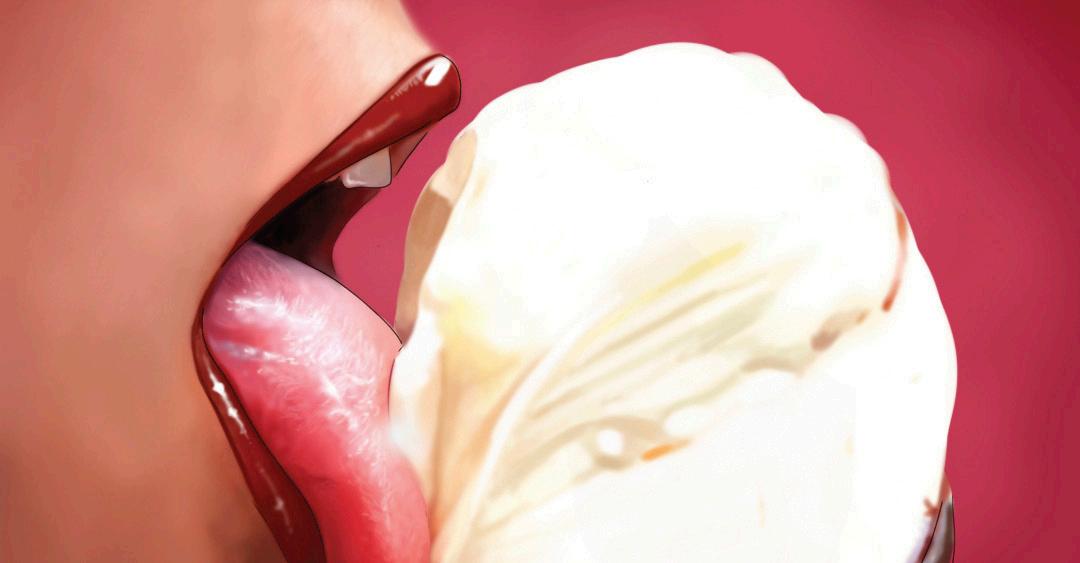
Situationships aren’t always all bad All’s fair in love and commitment: Reflections of a situationship survivorIsabella Liu Associate Comment Editor
Last year, for The Varsity’s Love and Sex issue, I took on the gruelling task of playing Valentine’s Grinch and wrote about digital cheating and how sex is overrated. Admittedly, it didn’t reflect well on my personal life, so, in the grand scheme of cynicism and grouchiness, I swore to myself — and my love life — that I’d write about something more cheerful this time around.
Oops.
That’s not to say what I’m about to discuss is completely downright depressing, though — rather, the word I’d use for it is probably entertaining. Enlightening, if you will. Being a Comment-er, seldom do I write anything personal, and thus, I’ve always figured, my first “me” article should probably be about something pretty impactful to my life. Considering how my 2023 went, this seems about right. So here goes.
By now, the word is practically household. The Oxford Dictionary named it as a 2023 Word of the Year finalist, on account of how popular it became in the last year. Between the “POV” skits and think pieces about it on TikTok, the concept of a “situationship” is a stranger to none and traumatic to many.
On the outside, it seems easy to scrunch your eyebrows and logically question it: how does one fall for something like a situationship so easily? Hell, in my own retrospective, it’s almost laughable. But truth be told, you’d be surprised.
Situationships are the embodiment of suspense. They’re the silent three minutes in the morning you spend staring at the toaster right before it pops and reveals whether you’ve got some golden Wonder or burnt crap. They’re the nerve-wracking period between when you submit your last assignment
and when your final grade is released, and this godforsaken institution finally tells you whether or not you’ve flunked Economics of International Trade. The constant limbo of neither nothing nor everything, between strangers and lovers, puts Schrödinger’s Cat to shame.
It’s that thrill of ambiguity that makes it so easy to get caught up in one. There’s a kind of insanity that you derive from the constant questioning of “what are we;” the overanalyzing of every little word they utter; the thinking and dissecting of their actions; and the “did he just drunk text me that he loves me?” that is so attention-grabbing and timeconsuming — yet exhilarating.
A situationship is one long talking stage: the era where everything is exciting, colourful, and borderline obsessive because it feels like something new is coming, something big is on the horizon, and you can absolutely feel it heading your way. All you know is that there’s something to want, something to discover, and that’s enough to keep you hooked.
So yes — like any viral video rant will tell you, a situationship is crazy. To many, it’s heartbreaking, devastating, and worse than a breakup; the reasons are too many to count. But in honour of this spicy week, allow me to offer a hot take: they’re not always bad.
We now live in an era where the standards of dating and commitment have changed for the better. From one-night stands to friends with benefits to polyamory, people are redefining relationships to whole new extents and turning norms of commitment and loyalty into a spectrum based on consent and comfort. A 2023 Match survey revealed that 31 per cent of singles in America have been in non-monogamous relationships, and Canadian polling and market research firm Abacus divulged that a quarter
Pornography and its stigmatization of vanilla sex
Hannah L. Fegley, in her masters thesis at Smith College, wrote that pornography — specifically through sites such as PornHub — influences our ideas of consent. Fegley found that people were more likely to interpret non-verbal cues as sexual consent if they perceived pornography as realistic. One obvious issue is that we don’t see negotiations happening before more violent scenes in porn, and we don’t know about the specific actions that actors consented to.
While depictions of sexually available women in porn may lend to the idea of men’s sexual fantasies, I believe porn also sets a precedent for a lack of informed consent between sexual partners. It suggests that the women in porn accept violence without consent. In popular media, I’ve even seen the idea that having consent “ruins the fantasy,” or that asking for consent would “ruin the mood.”
I have heard some men that I know argue that power dynamics in sex emerge organically because of preconceived gender norms, and I am not going to disagree with this — however, I believe the type of sexual violence that we see directed toward women in real-life relationships is atypical. Pornography lays a perfect patriarchal blueprint for the way women “should” be treated during sex and the lack of visible consent that comes with it.
The stigma that surrounds vanilla sex directly feeds into the patriarchy’s aims. Patriarchy seeks to keep women subordinate, and it can do so by accepting sexual violence under the guise of liberation and using pornography to perpetuate dangerous ideas about consent — or the lack thereof.
At the end of the day, chains and whips can excite. And if that’s your preferred mode of getting it on, let your freak flag fly! Just remember to keep it safe, sane, and consensual. But also remember that vanilla sex isn’t dead; in fact, it can be incredibly rewarding. Vanilla sex can bring emotional connection, intimacy, and self-confidence.
I’d say find someone who listens when you speak and asks you questions about yourself. Then put on your favourite sultry album, light some candles, and have the mind-blowing vanilla sex of your dreams!
Amelia Spong is a first-year student at Woodsworth College studying humanities.
of Canadians in 2022 were open to open relationships.
I see the norms of strict monogamy and traditionalism finally coming to an end: love and sex are now an exploration of ideals, an adventure rather than a responsibility, and that isn’t necessarily bad.
I’d argue that situationships should specifically be placed between friends with benefits and a full monogamous relationship. There is a lot to learn and enjoy in situationships, especially once you get used to the constant excitement. They offer a level of emotional connection and development which you wouldn’t normally get from a cut-andgo circumstance like friends with benefits but still allow you to keep a greater amount of freedom and individuality that’s usually more restricted in a formal relationship. If that works for you, and that works for your partner-but-not-a-partner, then there’s no reason to fix what’s not broken.
Of course, this is under the premise that the situationship consists of two consenting individuals with the same outlook on love. In my view, this fun and freedom can only be free of others’ suffering when neither party wants to go deeper into the relationship than necessary. Otherwise — well, maybe it’s time to start searching up “situationship” advice on TikTok.
In the grand scheme of things, situationships don’t always have to end as if Hurricane Cupid tore through your heart. Nor do you have to panic if you might be in a situationship right now: you’re not automatically in the wrong and headed for shark-infested waters. If you find comfort in where you are and know they do too, that’s nothing to go crying home for.
Who knows? Maybe, in the long run, you’ll develop a friend for life from your situationship. I know I did.
Isabella Liu is a third-year student at Victoria College studying public policy and international relations. She is an Associate Comment Editor at The Varsity.

 Mia Jakobsen Varsity Contributor
Mia Jakobsen Varsity Contributor
What is the modern formula for finding love?
Rom-coms or shows about love and sex tend to suggest that a meet-cute — for instance, bumping into each other on the sidewalk à la Carrie Bradshaw — is a crucial step. Even in Nora Ephron’s You’ve Got Mail, a rom-com about two people in an online romance, it turns out that the protagonists are unsuspecting business rivals who hate each other in real life!
However, the digital age has transformed, or perhaps impeded, how couples meet. A Stanford study from 2019 revealed that for straight couples, meeting romantic partners online has become the most likely way for relationships to begin, replacing traditional methods of meeting through friends, family, or spontaneous meet-cutes.
Dating apps have revolutionized how we meet and interact with potential partners. It breaks down geographical barriers and allows us to explore connections beyond our immediate social circles. It caters to a diverse range of preferences and allows you to get to know other users through interesting prompts, photos, and music. Matchmaking algorithms on dating apps now do the work of finding the right person for you. By sifting through the settings, the app can find numerous people who have specific habits that suit you.
The modern formula for finding love seems entirely dependent on an algorithm, as dating apps seem to be the first place we gravitate toward finding a partner. This fact might be helpful to people like me — planners and picky daters — but it can leave some users feeling disconnected, disillusioned, and longing for a sense of authenticity in an increasingly artificial landscape. It seems impossible to date correctly online because these algorithms minimize the experience and impact of a possible relationship to a swipe of your finger.
Online dating is a complex world that increasingly frustrates users, and as dating apps continue to prioritize quantity over quality, it seems like the reason for joining an app — genuine human connection — gets sacrificed in the process. Dating apps claim to care about users finding love — Hinge’s slogan emphasizes it as a “dating app designed to be deleted” — but I find that the algorithm that can supposedly find your perfect match has begun prioritizing exclusive users who spend money.
Tinder SELECT is Tinder’s newest exclusive membership, available since September 2023 for the cheap monthly cost of 499 USD! While typical Tinder users can only message those they match with, Tinder SELECT users can message anyone they like — regardless of a match. The membership
will also prioritize SELECT users’ profiles for other users they like.
Tinder SELECT epitomizes dating apps’ misplaced focus on exclusivity and status over compatibility. The membership operates on the premise that superficial criteria such as wealth and status take precedence over romantic compatibility. This premise fosters what I see as a toxic environment where users can now get messages from strangers without their consent, all because the stranger paid 499 USD.
A CNN article examining Tinder SELECT said that paid subscriptions are intended for serious daters to “find other serious daters amid the seemingly infinite number of free profiles… on apps just for fun.” I believe that this approach by Tinder gets the essence of online dating wrong. There are plenty of people who use dating apps for fun, but dating apps have an option for people to share their intentions on their profiles, and paying for an app does not signify a deeper intent to find love. Paying more to indicate higher interest perpetuates a distorted perception of what love and intimacy are and who is worthy of it.
Prioritizing ‘elite’ users in an already complicated algorithmic system undermines the very essence of what it means to truly connect with another person — the supposed goal of dating apps. Rather than providing broader options of possible connections, Tinder SELECT narrows users’ chances
The gamification of dating is detrimental to the joy of relationships
Everyone wants to feel like they belong. We are social animals, and in Maslow’s “hierarchy of needs,” social connection is only superseded by the physical and safety needs required to stay alive. Beyond the basics of living, our first need for a fulfilling life is belonging.
Years ago, I remember pining after the idyllic concept of a relationship. To me, romance was the epitome of belonging — to be chosen above all others. One, in theory, can have unlimited friends, but in traditional monogamous romance, only one partner.
The pursuit of that ideal, however, is not easy. Modern communication makes connection convenient and abundant, but with so many options, the culture around dating is shrouded in ambiguity. I see modern dating as gamified and mechanized, a scene that I think hurts those seeking genuine connection.
The conflicting interests of culture and daters Dating is hard but often emotionally fruitful. Researchers from Wake Forest University and Florida State University found that married people often experience better physical and mental health. They found that this also extends to early adulthood, with supportive relationships associated with better mental health.
However, relationships nowadays are hard to find, and modern dating culture only amplifies these issues. For instance, an article from Glamour touches on the modern progression of relationships: “‘The talking stage’ is a label apparently coined by Gen Z’ers to describe a maddening, un-defined early stage of many relationships,” it describes. An interviewee described the talking stage as when a couple is “doing everything that is required of a relationship without the relationship title.”
In other words, ambiguity is a defining feature of modern dating culture. In the same Glamour article, Logan Ury, Hinge’s director of relationship science said, “One big trend that we’re seeing
among Gen-Z daters is just more comfort navigating ambiguity, less attachment to titles, and being more fluid in general.”
The causes of this ambiguous nature are obvious to me: sometimes, we’re not sure if a relationship’s benefits outweigh its risks, and most times, we don’t really know what we want.
A 2008 study on speed dating from researchers at Northwestern University shows that people often indicate that characteristics such as income potential or attractiveness are important to them, but their responses to actual potential partners do not reflect those stated attractors. I believe this lack of self-awareness when it comes to what we seek in a relationship, mixed with the ease of modern connectivity afforded by social media apps, has set the stage for the exploratory, ambiguous culture we see today.
Exploration and ambiguity harm people seeking love
People have described to me their talking stages — the people they’ve been simply exchanging Snapchats with or their numerous potential options that are only a smartphone tap away — and I come away with a sense of linearization in the dating process, as if there is a straightforward way to it. The detachment and mechanization of it felt wrong.
To me, these gentle forays into talking stages are breeding grounds for emotional damage to the unprepared. One popular TikTok articulated an iteration of the modern ‘situationship,’ where both parties are looking for something different and, in this disparity of feelings, one side typically gets hurt. This becomes a cycle when the wider culture starts perpetuating these rifts, and victims and perpetrators blend into one as these norms of interaction become more deeply entrenched.
When the person you are in the talking stage with is also talking to other people besides yourself, or just lacks the reciprocated care that you are giving, it becomes easy to fall into the same routine of interaction, perpetrating the issue of wide-cast but gamified and calculatingly reserved dating.
Yet, even in this culture, most people are still seeking genuine connection. A study from the
University of North Carolina Charlotte, shows that among students using dating apps, love and the pursuit of a relationship was the top motive. However, when our culture promotes acceptance for the pursuit of every degree of attraction, rather than only the most heartfelt, it makes it difficult for people to pursue the love that they are really looking for.
I believe dating has been gamified, using questionable metaphors like the age-old “rounding the bases,” as if there’s something to be “scored” in a relationship. When they face the high volume of potentially romantic interactions and incrementally progressive but ambiguous “steps” of a relationship, I think it is completely understandable for those seeking love to become discouraged.
On the other hand, this fluidity and culture of exploration can statistically be greatly conducive
CHRIS ZDRAVKO/THEVARSITYto build genuine and compatible relationships. It perpetuates a culture of superficiality and exclusivity, ultimately undermining the algorithm’s chance at finding you love in the digital age.
I am part of the tiny population that has been very lucky with my experience with dating apps; I’ve never had a bad experience with them, and I met my current partner of two and a half years there. Although most couples dislike answering the question of how they met with a plain “online” — as they prefer telling an interesting and “awww”provoking story — I don’t quite mind that we met online.
Whether you have a physical meet cute or meet thanks to an algorithm, building a romantic relationship with someone requires the same authenticity, vulnerability, and mutual understanding. In a world increasingly dominated by technology and superficial interactions, cultivating genuine intimacy requires conscious efforts to build a strong foundation that transcends any constraints of the ‘fake’ digital realm — not a subscription plan worth a couple of extra hundred dollars.
Mia Jakobsen is a third-year student at Victoria College studying book and media studies, sexual diversity studies, and digital humanities. She is the president of the Book & Media Studies Student Association and the director of marketing and outreach for VicPride.
to finding your perfect match. How can you know what you like if you’ve never tried anything? But after all that ambiguity, how will you appear genuine once you find that special someone and have to progress beyond the casual, exploratory, and streamlined search that has permeated our culture?
It is clear why this ethos has prevailed in modern dating. Connection is too easy, our feelings too vague, and our futures too uncertain. Current dating culture is difficult to navigate and makes feelings hard to discern, but many people out there are still ultimately seeking love and the benefits that relationships bring. These difficulties may hinder progress toward that goal for many, but I believe the culture of seeking has not changed our innate desire to yearn for connection.
I believe that there are still people out there seeking love and genuine connection, even if you may have to look a little harder to find it. After all, isn’t anything worth having worth fighting for?
Max Zhang is a first-year student at Woodsworth College, studying computer science. He is the Mental Health columnist for The Varsity’s Comment section.
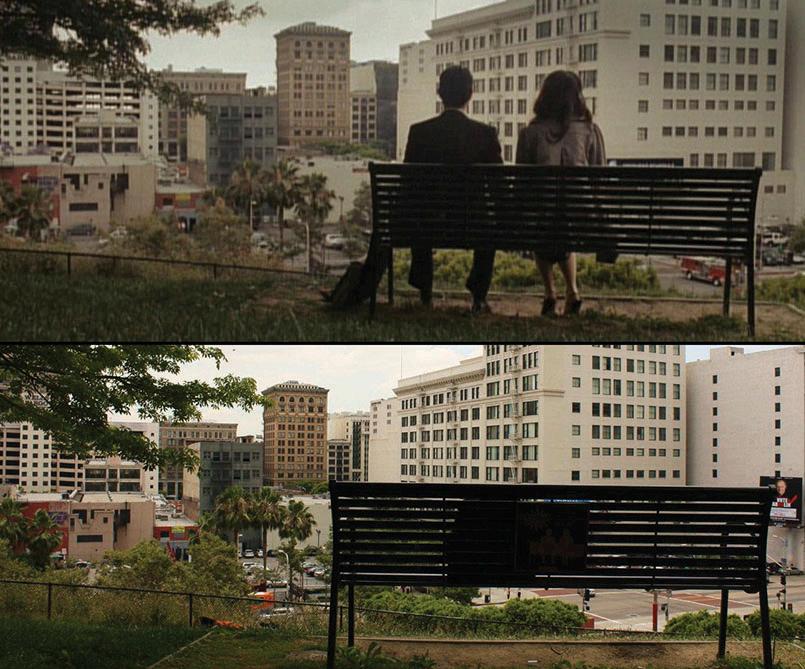
idea isn’t scientifically accurate, according to U of T researchersParmin Sedigh Science Columnist
Love is complicated. So when a book comes along that promises to simplify the way we express love and prescribes ways to improve our relationships, we jump to embrace it.
The love languages craze was started by a Baptist pastor, marriage counsellor, and anthropologist named Gary Chapman, who first published The 5 Love Languages: How to Express Heartfelt Commitment to Your Mate in 1992. Ten thousand podcast episodes and 500 million TikTok views later, love languages have become a ubiquitous part of pop culture.
The book’s premise is simple: every person has a primary love language — a way in which they prefer to receive love — and many relationship problems arise from clashing love languages between partners. But a 2024 article by relationship scientists Emily Impett, Haeyoung Gideon Park, and Amy Muise at U of T and York University suggests that these concepts are not scientifically accurate. Instead, they propose a new analogy: love is like a balanced diet where we need all nutrients to maintain a healthy relationship.
Does every person have a primary love language?
Despite the popularity of love languages, some researchers haven’t taken Chapman’s claims seriously for years. Relationship scientists have been conducting studies testing the validity of Chapman’s claims since 1992.
“Maybe… part of our job is figuring out what are the things that people are actually really interested [in] out there in the real world with their relationships [and] seeing if there’s any empirical evidence for them,” said Impett — a professor in the Department of Psychology at UTM and the director of the Relationships and Well-Being Laboratory — in an interview with The Varsity
Reviewing 10 previous articles, Impett and colleagues debunked three claims made by Chapman, one by one. They first looked at the idea of having a single primary love language from a set list of possible languages — words of

affirmation, quality time, receiving gifts, acts of service, or physical touch.
In The 5 Love Languages, Chapman mentions that each language can have various “dialects.”
For example, words of affirmation can include a partner giving compliments or remaining kind in the face of conflict. However, he maintains that each person has only one primary love language.
This may be because the quiz Chapman proposes individuals take to find their love language forces them to pick between options such as holding hands and receiving compliments.
In most relationships, we can have both. Denise
Polk and Nichole Egbert at West Chester University in the US conducted a study where they didn’t pit various ways of expressing love against each other,but assessed independently.
In this study, most participants rated all of the love languages highly.
Another myth about the original love languages model is that there is a clear division of five distinct ways to express love. Research in 2011 by Laura Stafford at the University of Kentucky, for instance, found seven categories rather than five: positivity, understanding, assurances, self-disclosure,
It’s not you, it’s Tinder
Alyssa Ukani Associate Arts & Culture Editor
Dating in the twenty-first century is far from glamorous. Between being ghosted, catfished, and having to put up with the same nauseatingly cringy pickup line over and over again — to name a few of today’s dating struggles — it’s easy to claim that finding love just isn’t what it used to be: that it is more trouble than it’s worth and that it leaves us feeling self-critical and less confident.
If you couldn’t tell already, I have no particular love for dating apps. I don’t believe they work; everywhere I turn, I hear about a failed online relationship or a dating app horror story. Just about everyone has had, or knows someone who has had, some type of foray into online dating, and can relate to the love-hate relationship with dating apps that ensues from it.
Feelings of hopelessness, frustration, and burnout are common on dating apps — so much so that some apps have attempted to address the idea of “dating burnout.” Some of these ways are more performative than others, but I digress.
Multiple studies over the last half-decade have shown, however, that these feelings are not of your own making; they’re actually the impact of using the dating apps themselves.
The link between online dating and well-being
A study published in Information, Communication & Society in 2021 conducted by researchers at Erasmus University Rotterdam provided some insight into common claims about dating apps. The study took the form of a self-report survey of 296 Tinder users, investigating the association between Tinder users’ habits on the app and their well-being.
While they found associations between increased “joviality” and both compulsive usage of Tinder and using the app for relationship-seeking, the researchers still concluded that Tinder usage can “trigger more negative effects than positive.”
The problems with dating apps lie in the behaviours that their users engage in, such as making self-conscious social comparisons. These social comparisons involve measuring one’s own social status based on where one stands with others. These comparisons are particularly common when users feel unsuccessful in their online dating pursuits, and the researchers found they were associated with feelings of sadness and anxiety, as well as decreasing joviality.
This is by no means the first investigation into the impacts of dating apps on mental health. A similar 2020 study, published by researchers at Western Sydney University, found that people who used swipe-based dating applications (SBDAs) had higher psychological distress and depression
relationship talk, sharing tasks, and involvement.
Impett and colleagues explained that Chapman’s categories were born from a top-down approach. Chapman began with his own thoughts and theories and may have imposed those onto the couples he counselled. By contrast, Stafford’s seven-category model emerged from a bottom-up approach where study participants were first asked how they wanted to receive love. Researchers later drew connections from the results.
Chapman also claimed that for a relationship to be successful, partners must learn to “speak” one another’s love language. However, William J. Chopik and colleagues, in a 2023 study, “have looked at couples where partners have the same love language, [and asked], ‘Are they happier than couples where partners mismatched?’ And no, there’s no evidence for that,” said Impett in the interview.
The homogeneity of Chapman’s sample was another problem plaguing the love languages model. In his book, the examples of couples used by Chapman focus exclusively on mixedgender and religious couples, perhaps skewing the patterns Chapman noticed.
Less about languages of love, more about its ingredients
After debunking Chapman’s claims, “we thought it would be equally important to provide an alternative, easily digestible message that avoids suggesting people can be fit into arbitrary boxes or there is a quick and simple fix for relationships,” wrote Park, one of the coauthors of the study and a doctoral student at the Relationships and Well-Being Laboratory, in an email to The Varsity
The new metaphor proposes that relationships should be treated as balanced diets where partners need to receive love in many ways to have a healthy relationship. At different points in time, one might need more of a certain expression of love, as a runner may need more carbohydrates. But overall, all nutrients are necessary for a healthy relationship.
In the final pages of his book, Chapman writes, “I have not written this book as an academic treatise to be stored in the libraries of colleges and universities.” Given these results, perhaps that’s for the best.

compared to non-users. Even more concerning is that the Western Sydney University study also indicated that increased frequency and duration of SBDA usage increased the severity of these symptoms.
While these results do not prove unequivocally that dating apps are the sole contributor to the burnout you feel scrolling through potential matches, they’re definitely something worth noting before spiralling into thinking that you’ll never meet ‘the one’ simply because they didn’t pop up on your screen.
Why do we keep coming back?
However, despite the negative mental health effects, people do keep going back to the apps: in the Western Sydney University study, 26.1 per cent of SBDAs users, both current and past, met more than five people during their time on the dating app. This may be explained by the fact that 40.4 per cent reported dating apps had a positive impact on their self-esteem while only 28.7 per cent reported negative effects on their self-esteem.
Other research by scientists from the Multimedia University in Melaka, Malaysia in 2023 has suggested this behaviour occurs because dating apps activate a reward pathway in our brains — the mesolimbic dopaminergic pathway. This is the same pathway that is also activated by slot machines and addictive drugs. With every dopamine hit, you’re roped back in to keep swiping, unaware of any adverse effect it might have.
The researchers at Erasmus University Rotterdam concluded from their study that dating app users must be aware of their habits, such as comparing themselves to others or compulsively using the dating app in question. Understanding the impacts that dating apps can have on a given user’s well-being may allow them to minimize the negative effects of those apps where possible. The results from the study in Sydney, though, suggest that most people are far from that level of selfawareness.
Maybe, then, the perfect plan for Valentine’s day is simply to delete the dating apps. You’ll find someone, I promise — just maybe not on Tinder.
What does it mean to be in love?
Is it a chemical reaction? An undefinable experience? Or, as one 2016 scientific paper from Sri Ramachandra University describes it, “an emergent property of an ancient cocktail of neuropeptides and neurotransmitters?”
To me, understanding any type of love only through the chemicals produced in the brain feels unsatisfying. After all, isn’t there something to be said about the subjectivity of love?
Oliver Sacks’ nonfiction book Musicophilia: Tales of Music and the Brain, Conor Stechschulte’s graphic novel Ultrasound, and Terry Gilliam’s film Brazil all feature cases of people or characters who continue to love in the face of memory loss or alteration. These cases discuss all the subjective aspects of love or affection and how they’re able to persist in situations we wouldn’t expect.
The curious case of Clive Wearing Musicophilia: Tales of Music and the Brain by neurologist Oliver Sacks describes Clive Wearing, a real-life musician and severe amnesiac who still remembers his love for his wife, Deborah, and for music.
In the ’80s, Wearing acquired a brain infection called herpes encephalitis, which left him with a memory span of a few seconds. Despite this, Sacks describes him recognizing and finding great comfort in Deborah, although he couldn’t remember their time dating. He also could play pieces on the piano with the intensity and emotion of his pre-amnesia years, a sign to Sacks that Wearing’s case said something unusual about the way we remember music.
Early on in the chapter, Sacks makes the important distinction between semantic memory, episodic memory, and procedural memory. Semantic memory is knowledge of facts and other data, essentially knowledge about something like an event or object. Wearing retained this to an extent and could hold scattered but still enthusiastic conversations about topics he was interested in.
Episodic memory is what structures procedural and semantic memory; it is the memory of events and lived experience, and the part of Wearing’s memory that is highly compromised due to damage to his hippocampus and temporal lobe structures. The temporal lobe is responsible for our ability to process language, emotions, memory, and sensations. The hippocampi transfer short-term memories into long-term storage, which is what makes them so important in the study of long-term memory loss.
Wearing’s episodic memory was so damaged from his infection that he was unable to retain events for more than a few seconds, and couldn’t remember most people consistently aside from Deborah, his grown-up children, or his grandchildren.
Procedural memory, the memory of performing tasks, Sacks describes, involves “larger and more primitive parts of the brain” such as “subcortical structures… and their many connections to each other and to the cerebral cortex.” It is easier to retain procedural memory than episodic memory in the face of amnesia, as subcortical structures are large and diverse, making them less likely to all get seriously damaged. This explains why Wearing could still dress himself, dance, brush his teeth, and play the piano.
What drew me to Wearing’s case was not its reinforcement of the distinctions within memory
but rather the fact that he retains a deep love for his wife, who in turn shares his love for music. To Sacks, it seems that there is a connection between the profound emotion he experienced for Deborah and his sustained ability to play music with a similar level of emotion — this wasn’t just procedure or facts he was retaining, but a deeper feeling.
Conor Stechschulte’s Ultrasound on the effects of emotion on memory
In the graphic novel Ultrasound (2022) by Conor Stechschulte, the protagonist, Glen, finds himself stranded with a flat tire in the middle of a storm. He knocks on the door of a couple, and eventually agrees to have sex with the wife, Cyndi, so that the husband feels more secure in having taken care of her despite his depression.
The novel immediately makes it clear that things are amiss. When Glen tells his friend about the event, his friend contests the idea that it was raining that night, and in a flashback to the night, we see that Glen’s car had a flat tire because it ran over nails. The faces of certain people are smudged over in panels that are supposed to relay memories of what happened, and entire pages of the novel are covered in lines of rain or smudges that obscure the words on the page.
Unlike Wearing, Glen is not an accidental amnesiac. As the plot develops and Glen’s memory becomes increasingly contradictory and obscured, we learn that Glen is unwillingly part of a mind control experiment. Under hypnosis, Glen can be told to take a random action, and when snapped out of it, he will construct a story to make sense of that action.
By the end of the story, it is clear that Glen and Cyndi’s relationship is fabricated, if not through hypnotic suggestion then through the lies and trickery of everyone around them. Yet Glen
memory to which his brain clings. Here we see a bleak mirror of Wearing; despite his degraded memory, Glen retains enough emotional memory to still care for Cyndi.
Terry Gilliam’s Brazil, an epilogue on imagination
The movie Brazil (1985), directed by Terry Gilliam, also plays with the ideas of memory and love. Brazil is set in a futuristic totalitarian society. It is centred around a low-level government official, Sam Lowry, who sees a woman from his dreams named Jill in real life. He chases her around the city, driven by curiosity and his increasingly disturbing dreams.
As the movie goes on, Sam’s imagination and reality blur, leaving us to question the true relationship between Sam and Jill. Jill is often there and then not; her appearance and existence in the government’s system are as transient as Sam’s dreams of flying toward her with mechanical wings.
Is Sam’s episodic memory reliable here? Can his bearing on reality tamp down on his deep emotional commitment to imagining an escape with Jill? Sam’s imagination is also similar to amnesia — his ability to distinguish between what is memory and what is constructed becomes completely destroyed by the end of the movie. And yet, his emotions remain.
In all three of these cases, then, we see how emotions like love can persist despite memory degradation.
In a footnote, Sacks recounts a passage in Umberto Eco’s novel The Mysterious Flame of Queen Loana where the narrator hums a tune and yet forgets it as soon as he starts thinking about it. The narrator says that he is “living in pure loss” — but Sacks calls that same situation living in “pure gain.” Sacks writes, “The song almost miraculously seems to create itself, note by note, coming from nowhere — and yet… we contain the entire song.”

Sam’s story, his life in that totalitarian society, could be seen as the classic modernist defeat of man. But despite it all, Sam ends up smiling, hum-
Ever wondered why you’re drawn to certain people? Is it their eyes? Their outfits? Their personality? Picture this: a hidden code within your immune system, influencing who you’re naturally drawn to. Here enters the major histocompatibility complex, the unsung hero orchestrating the body’s defence and, as it turns out, a key player in the intricate game of love.
Decoding human mate choices
To start, understanding human mate choices proves to be a complex endeavour, as it ’s intricately woven with cultural influences, personal preferences, and biological factors.
Cultural influences play a significant role in shaping human mate choices. Throughout history, societies have developed norms and expectations regarding whom individuals should choose as their partners and often dictate certain characteristics that are deemed desirable in a partner, in terms of physical appearance, social status, or financial stability.
Personal preferences also contribute to the complexity of human mate choices. Each individual has unique desires and needs when it comes to finding a suitable partner. Some may prioritize intelligence or a sense of humour over physical attractiveness or financial stability. Personal experiences and values also shape these preferences, making each person’s criteria for choosing a mate highly subjective.
Biological factors can further complicate mate choices. Evolutionary psychology suggests that certain traits can be attractive due to their association with reproductive success. For instance, some men may be drawn to women with signs of fertility, such as an hourglass figure, because these traits indicate potential for healthy offspring.
Unveiling the immune system’s secret:
The major histocompatibility complex In a body composed of intricate organ systems, tissues, and cells, the genes that make up the major histocompatibility complex (MHC) stand as a guard against invaders. Acting as the body’s immune system orchestra conductor, the MHC molecules help immune cells
recognize and combat invading pathogens. It also offers a potential avenue for therapeutic interventions as recent studies have unravelled a fascinating link between the selection of a life partner and partners’ dissimilarity in a set of genes encoding the MHC.
Studies across various species indicate a common trend: a preference for mates with different MHC genes compared to their own. The mechanisms of this preference involve olfactory cues, suggesting that animals can detect these genetic differences through scent. This instinctive choice enhances the chances of producing offspring with a diverse MHC, providing better resilience against a variety of pathogens.
Surprisingly, humans can also differentiate MHC-related odours, though the exact way it works is up for debate. Many vertebrate animals have an organ dedicated to this sense of smell called the vomeronasal organ. This special organ is in the nose and is particularly good at detecting pheromones released during social and reproductive behaviours, such as those emitted when an animal wants to mate.
On the other hand, humans have cells called receptors in their noses that are used for communication through scent. Researchers are curious about how our noses guide our preferences, especially with body odours. It turns out, in several studies, that women consistently lean toward the scents of men with diverse MHC genes. It’s like our noses are wired to find diversity attractive, adding a whole new layer to the mystery of human attraction.
Potential evolutionary advantages linked to MHC-based mate selection in humans
As researchers explore MHC-based mate selection in humans, a tapestry of potential evolutionary advantages emerges. Particularly, MHC-dissimilarity may help enhance disease resistance in offspring by increasing immune system diversity, improving fertility rates,
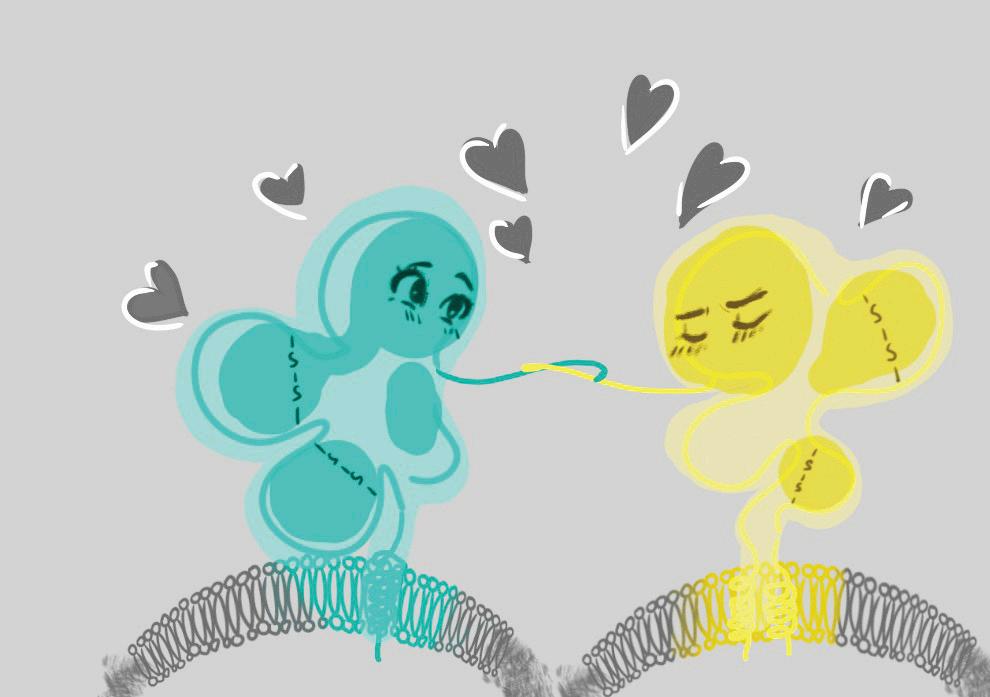
and causing greater sexual attraction and satisfaction.
First, by choosing partners with different MHC genes, individuals increase the chances of their children inheriting a diverse range of immune system genes. This diversity provides offspring with a robust immune system, less susceptible to a wide array of pathogens, particularly in environments where infectious diseases are prevalent.
Moreover, a study indicates that couples with dissimilar MHC profiles have higher fertility rates than couples with more similar MHC profiles. Genetically diverse offspring may possess better overall health and reproductive fitness, contributing to higher rates of successful reproduction. Choosing a partner with dissimilar MHC genes may also act as a safeguard against inbreeding depression, which can reduce the survival and fertility of future generations of offspring.
Finally, in the need for differentiating MHC genes, humans exhibit a preference for the body odours of partners with dissimilar MHC
Love can be an overwhelming, nauseating, but exhilarating journey, spanning from moments of nervousness in talking to your crush, to the spark of laughter from a playful joke. Sensations of butterflies — a sudden, joyful churn in the stomach — are probably a near-universal experience. They can arise in high-pressure scenarios like falling in love, as well as walking into the exam centre or eagerly anticipating a turn at karaoke.
Researchers have been investigating these “butterflies” and their origins for more than two decades. It turns out that a connection between our brain and gut holds the key to unravelling this enigma.
Our brains and gut communicate via the vagus nerve, a cranial nerve linking our thoughts and emotions to the sensations in our abdomen. Just as Pavlov’s dog salivated at the mere thought of food, our gut reacts to our thoughts and emotions in real-time.
So the phenomenon of butterflies in the stomach isn’t just a whimsical metaphor; it’s a complex interplay of biological processes set into motion by what scientists call our “gut-brain axis.” Within our gut reside a plethora of microbes that communicate with our central nervous system, ultimately shaping our thoughts, emotions, and behaviours.
The start of butterflies
According to a recent study, brain regions responsible for detecting stress signals are closely
linked with those involved in processing emotions. Initially, the brain’s sensory cortex processes information about things that could cause stress, which subsequently transmits signals to the limbic system — a collection of areas in the brain that regulate emotional aspects of stimuli, among other things, and includes the hypothalamus.
The limbic system then activates the hypothalamic-pituitary-adrenal (HPA) axis, the body’s main stress response system, made up of brain regions and hormone-releasing glands that control our physical reactions, and activate the peripheral nervous system. The “butterflies” feeling begins with the HPA pathway. When the pathway is activated, stress signals from the brain travel along the vagus nerve and collectively trigger a cascade of physiological responses through the body, including that fluttery feeling in the gut.
In the HPA pathway’s pattern of stress regulation, the paraventricular nucleus (PVN), located in the hypothalamus at the bottom of the brain, stands out as a central player. It not only processes signals from environmental stimuli but also sets off transmissions to neurons that help control the level of activation of the HPA axis, effectively orchestrating the body’s response to stress.
Within the PVN, diverse types of neurons respond to various stressors, including neurons that release the hormone corticotropin. These neurons are special because the amygdala relies on corticotropin to receive information about stress response and thereby regulate the stress hormone cortisol.
The nervous system also works to propagate this stress response throughout the body,
causing effects such as sweating palms, creating a harmonized series of stress responses in animals.
Studies in mice have suggested that gut mi crobes are affected by the levels of stress conveyed to them through the gut-brain axis, affecting which species of gut microbes are actually present. Differences in the amounts of microbes in the gut can change how the HPA axis and the PVN regulate stress levels in the brain.
Ultimately, it is the combination of all of these elements — the PVN, amygdala, the HPA axis, the vagus nerve, and gut microbes — that orchestrate the whirlwind of a sensation that is butterflies in the gut. This phenomenon thus shows that the impact our gut microbiota could have on our emotional experiences — including the rush of falling in love — is profound.
But what does all of this mean for our romantic encounters and
genes. This preference added to greater sexual attraction and satisfaction within relationships, which contributed to a desire to have a child with their partner. Additionally, partners were more dissatisfied with their relationships when their MHC genes were more similar.
Altogether, these potential benefits suggest that the consistent pattern in mating preferences for MHC-dissimilar mates isn’t merely a matter of instinctual choice; it’s a survival strategy.
While evidence suggests that MHC influences animal mating preferences, generalizing these findings to humans is more complicated – ; the intricacies of cultural, societal, and personal factors intricately weave into our mate choices, challenging simple conclusions.
And so, the question persists: are we truly wired to choose mates with dissimilar genetics? The answer may well reside in the intricate dance between nature and nurture, a dance that continues to captivate scientists, researchers, and curious minds alike.

What does it mean to be Canadian? Like any immigrant household, this question resonates through many generations in my family. If the Takeuchis were to answer this in a Mentimeter Word Cloud à la poli-sci lecture, the words “Vancouver” and “Canucks” would dominate the whiteboard.
Our collective love affair with the Canucks is more than an obsession. It’s an unrequited feeling of belonging. It’s about loss and pain, a grandiose and ineffable passion for an orca-faced billiondollar corporation that specializes in selling you hopes and dreams based on putting — or not putting — a rubber biscuit into a net.
I truly believe Canucks fans know sporting despair like no other creature on Earth. We are heartbreak heritage. But don’t get your lines crossed — this is nothing but a love story.
The Canucks played their inaugural season in 1970. My father would have been two years old, and my grandfather, Akio Takeuchi, would have been in his early forties. Aki, Vancouver’s first-ever sushi restaurant, was on the uptick in Chinatown, and with a new house on the hills of North Vancouver, my family lived a seemingly typical suburban life.
But the Japanese-Canadian community was still healing from their unique trauma from World War II. My grandpa and his older siblings had previously fled British Columbia to avoid being thrown into internment camps, the prospect of a war-torn and starving nation preferable to the uncertainty of staying behind. Most of my extended family were “placed” in the horse stables of Hastings Park. Their crime? Being legal Canadian citizens who happened to have Japanese heritage. The Canucks’ first arena, the Pacific Coliseum, opened within the grounds of Hastings Park in 1968.
The intergenerational effects of such dehumanization goes without saying. JapaneseCanadian and Asian families faced discrimination on the street, in restaurants, in schools, and on ice rinks. It would not be until the Canucks’ 18th
birthday in 1988 that the government would make a formal apology for its actions during and after World War II.
This was the Vancouver and the Canada my grandfather had fled and returned to. But for him, the Canucks brought something new to the city.
While I can’t speak on behalf of my late grandfather, I believe his purchase of season tickets in 1970 and throughout the following decades speaks for itself. Sometimes, I wonder which stars, what plays, and what games made him come back with his kids to the Pacific Coliseum for all those years.
obsessing over Leo Messi, Shinji Kagawa, and Homare Sawa’s new cleats. But the Canucks were always bubbling underneath my skin: it was a family tradition.
Like many hockey fans my age, my first hockey memory is Sidney Crosby’s Golden Goal at the 2010 Winter Olympics. I was visiting my grandparents in Vancouver, and we all huddled around the TV screen as Canada won gold on home soil.
That Canadian Olympic Team invigorated a slumbering Northern patriotism. The Hockey gods were pulling strings here too. I was soon to move

When my dad moved to Japan as an adult, the generational love affair my family had with the Nucks was seemingly put on hold. Growing up in Tokyo, ice hockey was unbelievably foreign to me. I knew my dad played in the local beer league, but their late-night starts meant that watching his games was out of the question.
At that time, all that mattered to me was the Japanese national soccer team. I spent my playground lunchtimes playing a 5-on-5 game, clamouring around soccer magazines, or
I remember seeing you in the garage at a very early age — a large blue flag hung above the window, with a big white leaf in the middle.
I always wondered what it meant and who you were. However, I never paid much mind to you — at least not until a few years later when I attempted to find a genuine love for hockey.
I tried to learn the ins-and-outs of the sport and connect with the players. But it just wasn’t working. I randomly picked a team to support that was sitting high in the standings — I thought that it would make me happier as a fan. But my love for hockey was just not blooming.
Years passed, and I realized I wanted to move to Toronto in the future. I fell in love with the city and began romanticizing what it would look like one day when that dream came to fruition.
But that’s also when it finally hit me. That flag that I used to see sitting in our garage as a kid was the Toronto Maple Leafs flag. What an unlikely choice for my dad to hang in the garage, as my family lived in Alberta. Nevertheless, it was at that very moment I knew it was meant to be.
I didn’t realize the trials and tribulations I would face as a new Leafs fan. The team had such a strong fan base, yet had not been capable of capturing the elusive Stanley Cup since 1967.
At that time, they hadn’t even managed to pass the first round of the playoffs in 19 years. So why would I support a team that never seemed to capitalize on so many opportunities?
It’s because it was so easy to connect to the Maple Leafs. I could feel the true connection that each of those players had with each other. And I can witness that love every night the Leafs hit the ice.
I don’t think I realized the love I had for this team until April 29, 2023. As I was sitting at the kitchen counter, watching the stopwatch slowly drain away, our captain, John Tavares, suddenly scored, beating the Tampa Bay Lightning 2–1. We won — the drought was over. The words “they finally caught lightning in a bottle” came out from the television, and I jumped with excitement, tears streaming down my face. Moments like this run through my head to this day. It was that feeling of finally knowing that we’re competitors in this league — that this team has a chance to win the Stanley Cup.
I’ve experienced the pain of watching players get traded and flourish with their new team. I’ve watched players get injured, and I’ve also seen players go through some of their worst career slumps ever. But that disappointment and frustration only lasts for a short time before you realize that being a Leafs fan is so much more than that. We are unlike any other fans in the
to Sydney — and here he was, Sidney scoring the winning goal in my own hometown. When my dad showed me clips of the Sedins, Pavel Bure, Roberto Luongo, and Markus Näslund, it was love at first sight.
Nothing of note occurred in 2011. Please excuse the selective heartbreak amnesia. If you’re a hockey fan, you’ll know why.
In 2012, my world turned upside down. My family immigrated to Sydney, Australia, where footy, rugby, and cricket dominated the
playground. The plastic cricket bat scraping along the pavement was as close to a slap-shot as I would get. Yet, strangely, the further I was from Canada, the more Canadian I felt: I realized I had a Canadian accent, and that I said ‘sorry’ a lot.
I also took pride in loving a team and sport no one knew about — a sporting emo phase. Once, I saw a rogue Maple Leafs bumper sticker in Sydney’s Central Business District, and I remember how my eyes begrudgingly lit up. It was like I was in on the most wonderful secret in the world, the team logos forming a cryptic sign language for some secret society.
Moving to Vancouver at 15 felt like a grand homecoming. For the first time in my life, hockey was on cable. Classmates knew depth players like Tyler Motte and Kyle Burroughs. It was heaven.
Jump ahead a few years, and I’m now at U of T, supposedly an adult. I’m deep in enemy territory, but in my dorm room hangs an assortment of Canucks cards, a giant Canucks flag, my Canucks jersey collection, and polaroids of friends. Pieces of home on my wall.
I love Vancouver because of the sound of the rain on the window during after-school naps, the fog that settles on the hiking trails, and the ocean views as I go cliff-jumping in the summers. I also love Vancouver because we set fire to cars over our cosmically insignificant sport, and because our celebrity fan, Michael Bublé, trips out on psychedelics at the All-Star Game — a true BC boy. I know fans who refuse to eat at Subway because Mark Messier did an ad with them. Although I’m somewhat ashamed of it, I have an orca tattoo on the back of my leg — sorry, Mom.
After 54 years in the NHL, we have yet to win the Stanley Cup. We’ve lost all three of our playoff final appearances and rioted twice. Years upon years of mediocrity and misery, with many more to come.
But, like that one name on your blocked list, I just can’t tear myself away. To love the Canucks is to be Canadian. A Vancouverite. A British Columbian. And a Takeuchi. We are ready to get heartbroken over and over again.
It’s a good thing we’re winning the Cup this year.
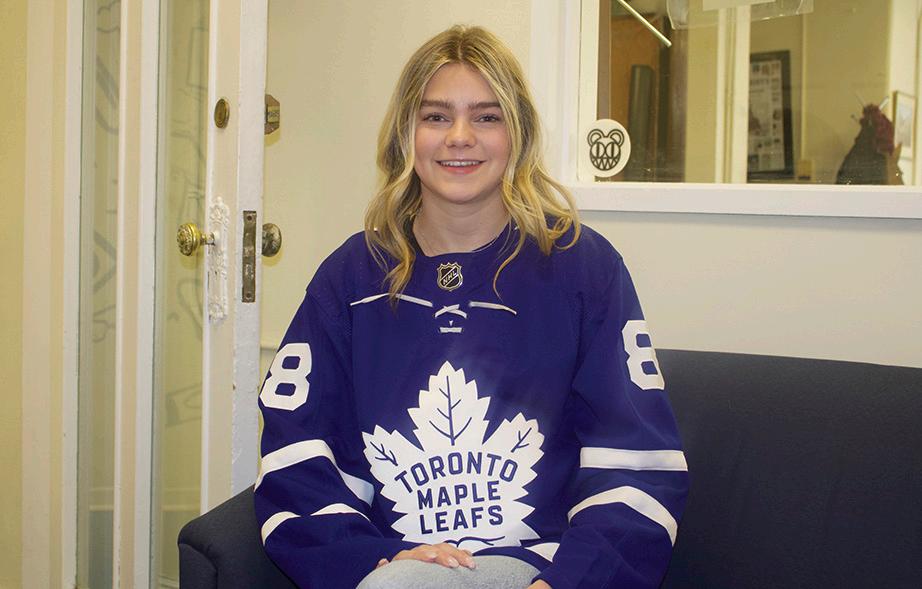
Samantha’s love for the Leafs has bloomed over the years.
world. With our passion, respect for one another, and competitiveness, we radiate such an excited energy that you cannot resist continuing to cheer for the Leafs.
This season, I watched as our star goalie, Ilya Samsonov, began to crumble. He lost his spark. The fanbase, his teammates, and the coaching staff could have simply given up on him. But we didn’t.
It’s in moments like these that I truly realize that my support for this hockey team runs deeper than purely enjoying the sport. It is the emotional connection you build as you learn more about your beloved hockey players and staff daily.
Whether you support them during their journey to a possible 70-goal season or attempt to uplift and nurse back a goalie who seemingly lost his confidence, I am always aware of the love that runs so deep.
To me, being a Leafs fan has become less about winning and more about enjoyment. Don’t get me wrong — I’d love nothing more than to watch our boys in blue hoist the Stanley Cup over their heads, declaring victory. But in the meantime, I go to sleep every night looking up at that big blue flag with the white leaf hanging on my wall, thinking about the team that truly stole my heart.
“NOOOOOOOOO!”
Charles Leclerc’s bone-chilling scream — after crashing out of the lead in the 2022 French Grand Prix (GP) — rings just as loudly in my ears as it did that day, watching from my hotel room in Orlando. But how does this memory explain my love for Scuderia Ferrari?
Early in my brief time as a Formula 1 (F1) fan, I quickly fell in love with the Rosso Corsa of Ferrari, and I knew 2022 was set to be our year. In the first three races, Leclerc and the Ferrari team had built a forty-six-point gap over Red Bull Racing’s reigning champion Max Verstappen. Yet, a run of engine failures and a strategic blunder that robbed Leclerc of a win in Monaco helped Verstappen claw his way back to a 38-point advantage over the Monégasque.
But coming off of a win at Red Bull’s home GP in Austria, Leclerc looked set to reignite his championship challenge, holding the lead in the 2022 French GP for the first 17 laps. What happened next seemed like it came straight out of a movie. Suddenly, the cameras cut to a car spinning off at the race’s eleventh turn and ramming into the barriers. My heart sank as I recognized the scarlet car. One scream later, and Verstappen was set up to win not only in France but in eight of the remaining nine races — securing back-to-back championships.
Ferrari’s struggles in the past decade make no sense. It is not only F1’s most valuable team, worth around 3.9 billion USD, but its history is steeped in success, boasting 16 constructor’s championships and 15 drivers’ titles — the most won by any team. Yet Ferrari has not topped the table since 2008, and you have to go back to 2007 for Ferrari’s last driver’s championship. In that sense, Ferrari fans and Toronto Maple Leafs fans share and follow the same annual narrative: delusions of victory only for their teams to find new ways to disappoint them.
Yet, like the Leafs, what makes Ferrari so enticing is hope. The hope that I felt as Leclerc briefly led in France. The hope that things could only get better, and never knowing whether joy or depression was waiting at the end of every race weekend.
One only needs to watch the reaction of the Tifosi — Ferrari’s ardent fan base — as Leclerc held off the Mercedes’ Lewis Hamilton and Valtteri Bottas to win the 2019 Italian Grand Prix and end Ferrari’s nine-year victory drought at their home Grand Prix. “Everyone is a Ferrari fan,” Sebastian Vettel, a former driver for Ferrari, once said — and on that day in 2019, it seemed like every F1 fan cheered just as loudly as I did when Leclerc stepped onto the top step of that podium. It’s the hope and desire we have to feel those same feelings again that helps Ferrari fans endure the pain.
That same hope translates to its drivers. Ferrari has signed some of the sport’s best drivers, and their current line-up is one of the most exciting
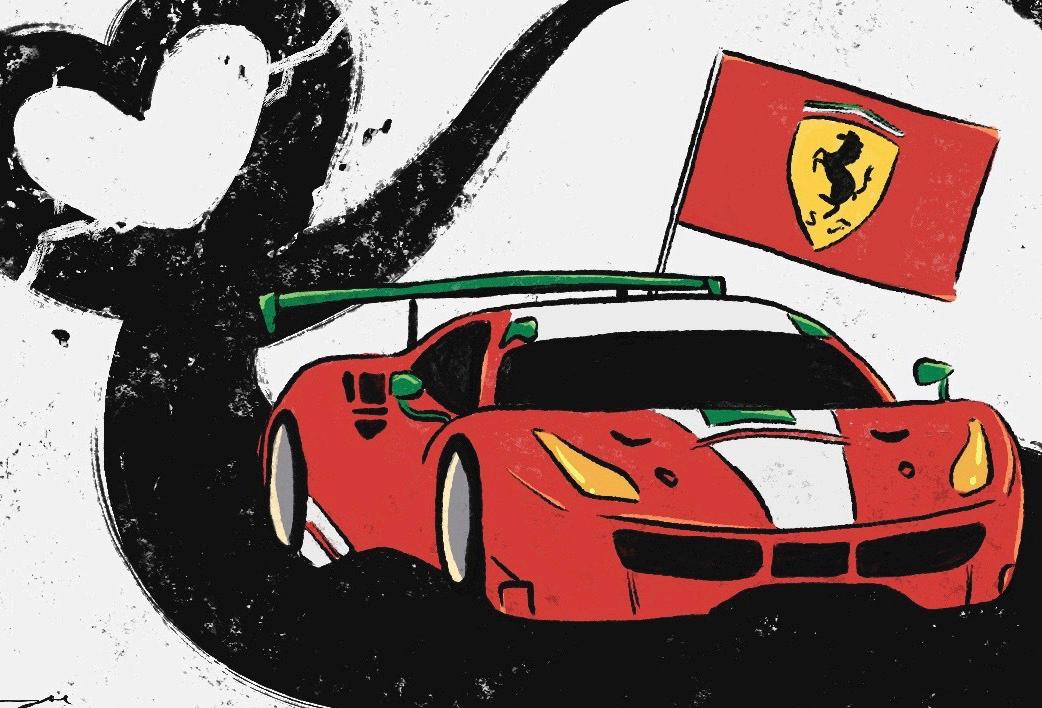
on the grid. Leclerc is arguably one of the fastest drivers over one lap. Critics point out his infamous pole-to-win ratio — 23 times taking a pole position compared to five wins — but, in an era where 74 per cent of the wins over the past five seasons have been taken by either Hamilton or Verstappen, to be consistently near the front, in an inferior car, points to Leclerc’s raw talent. It is the wonder of watching how Leclerc performs precariously on that limit of risk versus reward that makes his laps so intoxicating.
The same can be said for Leclerc’s teammate, Carlos Sainz Jr. Sainz can match Leclerc’s pace on a good day, and is also one of the most intelligent drivers on the grid. His two wins for Ferrari were at some of the most
enthralling F1 races in recent history — most notably, his move on Leclerc for race victory at the 2022 British GP, and his tactical driving at the 2023 Singapore GP, leading to the only non-Red Bull victory of the season.
So, why do I support Ferrari? It’s because, despite all their pitfalls, the passion of the fans, the exciting and talented drivers, and the team’s extravagant history cook up a formula for a team that you can’t help but love.
Plus, with Hamilton set to join the Scuderia in 2025, Ferrari will have one of the greatest driver lineups of all time. More pain is surely all but guaranteed. Yet the hope that Hamilton will bring Ferrari back to victory is a renewal of the vicious cycle of being a Ferrari fan — and I wouldn’t have it any other way. Forza Ferrari!
In case you’ve been on an internet cleanse since September 2023, Taylor Swift and Travis Kelce recently sparked nationwide attention when she attended a Kansas City Chiefs game to support him — officially hard-launching their relationship.
Like millions of others who have not histori cally kept up with football, I only found out who Kelce was last September. More precisely, on September 12, 2023, I received a Slack mes sage from a co-worker, which linked to an ar ticle detailing rumours about Swift and Kelce’s budding romance. Since then, I’ve witnessed countless social media posts and online de bates about whether or not Swift’s presence at games is ruining the future of the sport for good.
Swift’s fan base was quick to jump on the football train, but her presence at the September 24 game against the Chicago Bears and subsequent Chiefs games was not met with only rainbows and butterflies by everyone. Specifically, many longtime football fans and former players thought her attendance was distracting and would ruin their beloved game.
If we are trying to measure the Swift effect on the NFL in numbers, the stats tell a compel ling story in Taylor Swift’s favour. 24.3 million viewers watched the Chiefs play the Bears on Septem ber 24, 2023, making it the second most-watched NFL game of the 2023 season. When the Chiefs played the New Jersey Jets on October 1, it became the mostwatched game since the previous Super Bowl. On top of viewership numbers, sales of Kelce’s jersey rose 400 per cent after she first ap peared at one of his games. Overall, since that first game she attended, she has raised 331.5 million USD for the Chiefs and the NFL.
But as we all know, NFL fans are not all Taylor Swift fans. Despite the clear benefits to viewership and revenue, the increased presence of Taylor Swift across all of the NFL’s social media platforms and all of her shots on the jumbotron have stirred up some not-so-positive emotions. Many football fans have
showing Swift that much at all. At the Chiefs vs. Baltimore Ravens playoff game, she was only shown on the broadcast four times. She wasn’t shown at all during the second half, and her total screen time clocked in at 32 seconds. At other games she attended, she was only shown for 12 to 14 seconds. It would
celebrity in the audience distracts players, how does the Super Bowl happen every year?
As Swift told TIME , she has no control over how many times and for how long she is shown on the screen at the games she attends. She also doesn’t run the NFL social media accounts. If fans want to be mad at someone for the increased presence of Swift within the NFL’s social media accounts — which I will admit goes a little far sometimes — they should blame the NFL, which is probably just hoping to get a few — or a lot — of extra bucks.

Swift and Kelce’s relationship has done much more than benefit NFL profit lines and make some “dads, Brads, and Chads” — as Swift calls them — mad. In the past five months, some of those dads and their daughters have been bonding over a newfound shared interest in football. An interest in tuning into games to see if Swift is in the audience means that Swifties are learning positions and plays, and their family members who’ve been long-time football fans can feel more connected with them.
If football is about anything other than connecting with friends and family over a shared love and interest in experiencing the emotional rollercoaster of rooting for a team you’ve loved, then I think we are missing the point. Instead of focusing on the 30 seconds of screen time Taylor Swift gets or the many social media posts found on the internet, fans — of football and Swift alike — should focus on this newfound opportunity to deepen and strengthen their connections with people who might never have dipped their toe into the world of football without Taylor Swift.










Answers
